Text
Saturday, September 30th 2017
We actually went to Pompeii this time.
Breakfast was rather entertaining, because it consisted of a beautiful long buffet table of pastries and cakes and cereals and at the very end, next to the spoons, there was a small basket with a paper sign taped to it that said Gluten Free! and in the basket there were small packets of crackers, and also a bag of cookies that looked rather like the healthy but foul things you give babies to teeth on.
The cookies and the crackers were both much more pleasant than they looked, actually, and I had a very nice breakfast, though none of my friends took me up on my offer to try some of my awesome gluten free crackers instead of the croissant that they were going to have.
Their loss, honestly. Plus, because the crackers were individually packaged and it’s not like anyone else was having them, I could take a couple extra packets in my bag for the day, which turned out to be an excellent idea.
We left the hotel at 8, and arrived in Pompeii at 9. We left Pompeii at 4:30, which means we spent eight and a half hours walking through the ruins.
To be clear, I do mean that we spent the entire time walking, barring about thirty minutes in the middle set aside for a very quick lunch.
Things you should know about this adventure: My professor walks very fast. I am a below averagely tall person with below averagely long legs (I am not short, I am travel sized), and I walk fairly quickly for someone of my stature, mostly because I get rather aggressively competitive about walking speeds, in a way that suggests it was a good thing I never played any contact sports when I was a child, but while my determination usually beats out taller people who are less determined, it apparently can’t beat out a person who is equally determined and also a foot taller than me. He just bounds ahead, so if you get distracted for even a second he’s somehow managed to go through three other tour groups and is a block and a half ahead of us and about to turn the corner and be lost to us forever. During this day, I perfected a walking technique that was half jog, half leaping across things to make up for the length of my legs, with a little bit of controlled sprinting around corners and hoping that I wasn’t about to mow down a line of cruise ship goers with their bulky day packs and their slow moving tour guides who carry helpful flags and take them around to see the three most important things in about two hours before leaving, which meant that I could keep up, but only just. He never turned around when he was charging through the ruined streets (which, by the way, are made of uneven blocks of stone and clearly built with the express purpose of catching someone who is rushing along trying to keep up with her maniac of a professor and is already not the world’s most balanced human being and making her fall terribly, though that didn’t actually happen to me, by some miracle of fate), just kept going, until he stopped abruptly at whatever house or monument he wanted to talk to us about and looked back to find me and usually one or two other students gasping for breath and trying hard not to lean against any of the ancient, historically significant walls, while the rest of our class trailed in slowly, at a far more reasonable pace. He always looked vaguely disappointed in us for being out of breath, and not at all vaguely disappointed at everyone who arrived more than thirty seconds after he did. On one memorable occasion he announced, “My grandmother moves faster than you, and she’s dead!” to a kid stumbling through the doorway of a house, only to have the kid look up and say, mildly, “There are about ten more still coming,” at which point my professor humphed, gave the kid a glare, and then began his lecture like he wasn’t missing a third of his class.
It was probably the most entertaining field trip I’ve ever been on, and possibly the most fun too, even if everything hurt and I definitely got a sunburn. It was also southern Italy at the end of September, which meant that the temperature was in the high 80s, low 90s, and for once I could breathe without issue.
The amount of information he gave us about Pompeii was staggering as well.

We began the day in the Forum.
Pompeii is not originally a Roman town, incidentally. The original town was built and inhabited by the Opici, the native population of the bay of Naples, with architectural and religious influences by visiting Greeks, which is why the temple of Apollo located in the forum was originally built in the 6th century BCE, over three centuries before Rome would become a significant enough influence in Italy to convince other populations to adopt their practices.
The Opici held on to the territory for about a century and a half, until the 5th century BCE, when they were overtaken by the Samnites, who ruled happily until the 3rd century BCE, when Rome decided that they wanted to ‘friends’ with all of the other prominent civilizations in Italy. Samnite Pompeii became the ally of Rome, which basically meant that they were on call for any and all military needs Rome might have. This is also when the space recognized today as the forum of Pompeii was originally constructed, because the Samnites thought that if they copied Roman life, they could trick the Romans into not actively conquering them.
The Samnites were conquered in 89 BCE and rebounded as a Roman colony, which meant that nothing really changed except that all of the authority figures in the city were suddenly Roman instead of Samnite. The forum remained pretty much unchanged until the Imperial age of Rome began, and then temples sprung up to Augustus (the cult of the emperor, very important), Eumachia (actually just another temple of Augustus), and Genus Augustine (which is the Genus of Augustus, which is- you guessed it- just a temple to Augustus). The temple of Apollo also got a fixing up at this point, because Apollo was Augustus’s favorite god for propaganda reasons, so he put a shiny new inscription on it in Latin instead of the native tongue of Oscan, and stuck a sundial on a column outside because Apollo was the god of the sun, among other things.
We went from the Forum to the outskirts of the town, where funerary structures were placed outside the pomerium (sacred boundary walls of any Roman town or city, you weren’t allowed to do interesting things like bring weapons or declare wars or bury dead inside, so all that stuff just happened right outside the walls, carrying on the glorious Roman tradition of obeying the Letter of the Law to a T. Fun fact: Julius Caesar, whom I tend to abbreviate in my notes as JC to the amusement of me and myself, was technically not stabbed in Rome because that would have meant bringing violence into the city, instead he was stabbed in the Field of Mars, which looks like it’s in Rome because it is, in fact, in the center of what we would normally refer to as Rome today, but technically it’s outside the Pomerium so it’s not Rome, so stabbing the leader of the country is okay there! Also that’s why it’s called the Field of Mars, because it’s where people go to declare war and march the army around impressively, in order to not break the sacred boundary. Roman cultural customs are awesomely pointless most of the time, that’s one of the things I love so much about them).

This is what the pomerium of Pompeii looks like. It would have been much more impressive back in the day, before about 20 feet of ash was deposited on top of it and then two thousand years of dirt and plants settled on top of that. In front of it is a funerary structure.

This is another funerary structure. Note the statues inside. The dead from the super important families would usually get statues and also inscriptions informing any passersby about why they, and by extension their family, is very important to Pompeii and to the world at large, and so no matter what direction a traveler approached the city, they would have to pass by a who’s who of all the important folk, so that they’d be well-versed on who to suck up to by the time they actually entered the city proper. An excellent advertisement scheme, honestly.

There were also benches placed strategically around the funeral structures, so that one could sit and rest for a moment and also conveniently read about how so-and-so’s great grandpa was the bestest person who ever walked these streets and you should definitely go find so-and-so and kiss their sandals in thanks for having been allowed to walk the same streets as their illustrious close relatives.
The benches were also used for ceremonial purposes, in funerals and yearly commemorations.

This is perhaps a better look at what the pomerium actually was like, for size reference that little hedge at the top is a wall that comes up past my waist on the top walkway. Also, look how pretty this place is. So pretty. So green.

AMPHORAE
Moving on, we went into the houses.
The Roman house is set up in a fairly uniform fashion: there is an atrium, which is the first room one enters, that looks something like this:
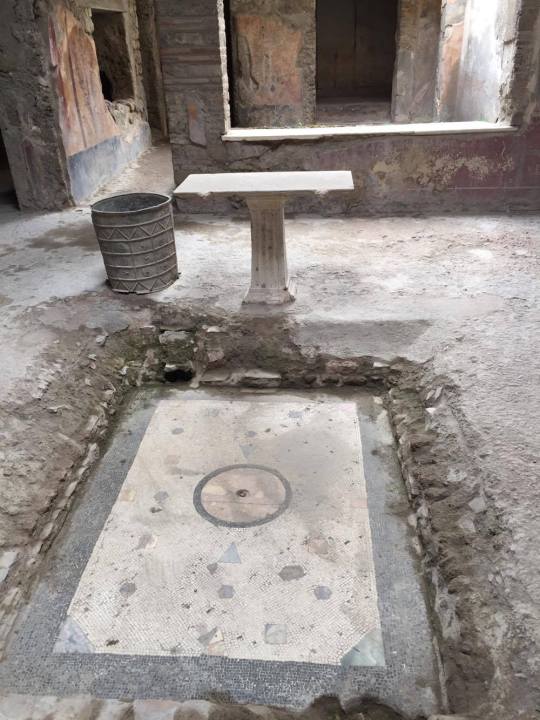
The atrium contains an impluvium, which is a fountain, and the ceiling has a hole in the middle over the impluvium, to catch the rain that falls through. In later centuries, after systems of aqueducts were implemented in most Roman towns, the impluvium became a more decorative element, but early on the household would have depended on that water.

This is a fairly good example of a complete atrium.
The atrium is a fascinating place, actually, because while we might equate it with an entry hall, or, well, an atrium, it was actually technically public space. People could enter a private house as far as the atrium without explicit invitation, and often did, as part of the patron/client relationship that Roman society functioned primarily on. A patron would be a fairly wealthy Roman citizen, and a client would be a less wealthy citizen, and they would essentially trade favors for favors, both politically and not. The atrium would be the place where clients most often went to meet with their patron. Patrons, also, could be clients of other, wealthier Romans.
Beyond the atrium lies the tablinum, which is the first technically private room in the villa (though you can see in the photograph that they were really pretty open-concept), in which is displayed a family archive. A little like plastering your entry hallway with every degree that has ever been awarded to a member of your family, and also every birth certificate, marriage certificate, death certificate, and also probably any time any family member has been mentioned in a newspaper. Like that, except fancier, because that’s how Romans roll.

Following the tablinum is the peristylium, which is basically a really pretty garden. Inside a house. It originally was just a garden, in the same way the impluvium was just a water source, but as the years went on and the Romans felt fancier, the normal food-garden turned into an aesthetic garden like the one in the photograph. Very pretty, lets lots of light and air into the house, good for hot mediterranean days, but virtually useless as a growing space.
There were two forms of art in a Roman house, typically: mosaics on the floor, and paintings on the walls. The mosaics were never on the walls, by the way, except in the case of fountains. If there was a water source, mosaics were okay for the walls.

The wall paintings, however, were vast and diverse without the extra benefit of tiles. There are four styles of wall paintings, and I am not going to explain any of them to you because I would end up rocking back and forth in a corner if I tried and I don’t want to do that.
(The trip was a combined trip with our Roman history class, and the Roman art history class, so we had a lecture about every. Single. Wall painting. There were many. None of the history majors understood what he was talking about when he said things like the scrollwork is reminiscent of xyz period. I still can’t identify the difference between second and third style, let alone fourth style, which is some kind of combination of both. I am not going to even attempt to explain them in this blog post, it won’t end well for anyone. We spent so much of that trip worried that we’d have to identify wall painting styles on the midterm. I can’t revisit that terror. I just can’t.)
So here are some walls, presented without comment!

I lied I’m totally commenting okay so that’s Dionysus right there, you can tell by the thyrsus in his hand. He was probably painted here in recognition of his status as a fertility god.

I like to call this one I’m Crying Because I’m A Floating Head And None Of These Birds Seem To Care About Me.



This is a series I like to call Help I’m Dying, Ooo That Looks Bad Sorry Buddy, and Stop Looking AT Us We Don’t Want To Help You.
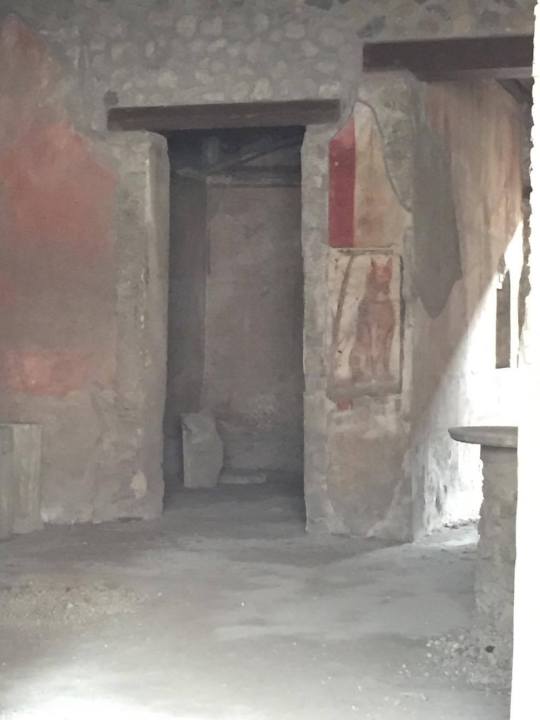
Wall Dog.

This is not a wall painting, this is the world’s coolest and most uncomfortable stool.
(It’s not a stool it’s probably the pedestal for a basin of some kind, but at this point I really wanted to sit down somewhere, anywhere, so I’m calling it a stool.)

This is a pomegranate tree. I just thought that was super cool. Look! Pomegranates! In the wild. Just. Like. Hanging around Pompeii! No one planted it! It’s just there! A pomegranate! Not in a grocery store! How cool is that!

The ancient walls of Pompeii, and also a solar panel. I just thought that was funny.

Centaur Butt.

The ceilings of some of the richest houses were also decorated with designs like this. They were, really, fabulously beautiful, even faded and half-ruined, and I wish so very much that I could have seen Pompeii in all its glory, before the earthquake in 62 destroyed everything and then the volcano eruption in 79 destroyed everything that they’d rebuilt. (Mother Nature was super into kicking the Pompeiians while they were down, turns out.)
With that, my tour of Pompeii is concluded, not because that is all that I saw on my trip, that is not, I saw so much, we were there for over eight hours straight, I think I was crying blood by the end of it, but to be honest I didn’t take any pictures of the rest of it because I was too busy detaching my soul from my fallible mortal body in order to pay attention to what my professor was saying without dwelling on how hot, tired, or hungry I was. It is also not, by the way, because I don’t have more information to shove down your throats, because I have so much more information, buddies, I have fifteen single-spaced typed pages (and over forty frantically scribbled handwritten ones that I have since condensed into a legible digital copy) of information that I could be telling you, but I really feel like you don’t care about how sometimes the Roman contractors cheated at villas by using a technique called opus craticium, where they used wooden frames filled with cement for nonloadbearing walls. I mean, if you do want to know all about that, just let me know and I’ll attach a link to my notes document for this class, it really is terribly fascinating when it comes down to it. Maybe then you can come take my final for me. That would be nice.
Anyway, after Pompeii we were lead on a forced march around two more villas, one of which had the most exquisite view of the city ever.

It was built on that cliffside for that view specifically, back before the view was quite so urbanized, and so were many other villas exactly like it, that were built I kid you not approximately five feet away from each other. Like. There is an alley in between each of these massive, sprawling villas. They could throw things at their neighbors. Easily. Heck, I could throw things at their neighbors, and I couldn’t hit the broad side of a barn door with a golf ball. I know this, because I have tried it, and somehow the ball went backwards instead and then hit me and I don’t know how that happened but I think the laws of physics in general just hate me. Me, personally. That seems way more likely than me just being really bad at throwing things.
After the villas, we went back to the hotel and collapsed into our rooms and I did not flood the bathroom taking a shower which I was really quite proud of (though I did manage to thoroughly soak my dress in the process, I don’t even know how, which meant that I had to wear what is technically a nightgown to dinner. It’s okay, mom, I can hear you panicking from here, don’t worry, it was one of the new ones. You know, the ones that look exactly like all of the dresses I wear because I spend 100% of my life dressing like I intend to sleep in my clothes. It’s an excellent practice that I highly recommend that leads to 100% more comfortable times when you accidentally fall asleep during the day in places that you probably shouldn’t, like on the bus or at a table or standing up leaning on a shopping cart.), and ate dinner, which was just as delicious as the night before. I like having dietary restrictions sometimes, you know, because I get my food first and no one ever asks for a bite. It’s quite nice.
I then finished reading Dante’s Inferno before I went to sleep because I might be on an academic excursion and I might have spent twelve hours hiking through various Roman ruins but that didn’t mean I could slack off on school work. Besides, Dante is great bedtime story material. You get to go to sleep with visions of Satan immobilized upside-down in ice while Dante and Vergil climb up his weird goat body to get to Heaven dance in your head.
#travel#rome#book review#I mean technically Dante’s Inferno is a book right and I talked about it for a hot minute right?#museum review#not actually a museum but like it’s Pompeii so basically?#I could tag this food eXCEPT WE DIDN’T EAT#okay that’s a lie we had thirty minutes to eat at two in the afternoon but mostly what I remember was eating lemon sorbet#so I didn’t think it was super pertinent to the story#though that was a fantastic move on my part sorbet was so important to my happiness on this trip#also if my professor is reading this: hi! I meant every word! :)
0 notes
Text
Friday, September 29th 2017
POMPEII, AND THE BAY OF NAPLES, IS A BEAUTIFUL PLACE.
Before I go into more detail, I just wanted to mention something. For most students at Temple Rome, they have chosen to study abroad here rather than elsewhere simply because our school has a campus here. It’s a study abroad opportunity, true, and they enjoy living here because it’s different from the United States, because they get to experience a new culture, learn a new language, and it’s in Europe, which means quick and cheap flights to anywhere within the EU. I don’t disagree with any of that, and I think they’re all perfectly, excellently valid reasons for choosing to stay here for a semester or a year.
That’s not why I’m here, though. I’m in Rome because it’s Rome. I’m not jetting off to Munich or Paris every other weekend because this isn’t just an easy access point for me. I’ve been studying Latin for six years now. I’m getting a degree in Classics. I never grew out of my little kid obsession with Greek and Roman mythology, and now I’m majoring in it. I was seven when I first picked up a book on mythology and I haven’t really put it down since. I’m in Rome. I get to walk along the Tiber each morning and see the Colosseum in the distance and that is ridiculous to me, even now, after almost two months. I’ve read letters and poems and speeches about the streets that I’m walking down to get to school every day and that’s insane.
Rome is a modern city, though, and it’s impossible to forget it, even with my imagination. So you can imagine how I felt wandering through the ruins of Pompeii.
I’ve been to Pompeii once before, on a day trip for one of my roommate’s birthdays, and we did a rather stumbling self-guided tour which, while very fun, was hardly informative. This particular trip, however, was an excursion associated with my Roman History course, lead by a professor who lives and breathes classical history, and who promised us before we left that it would be a death march through the ruins and we would get more information than we knew what to do with over the next three days. I was, as you might expect, very excited.
We took a big coach bus down on Friday, boarding at 7 in the morning exactly (I am not afraid to leave late students behind!! -Professor, on three different occasions when reminding us that when he says we leave at 7 he means we leave at 7). We were immediately given a forty some page packet of maps, floor plans, and letters of Pliny, and then left to fall, one and all, to sleep during the first couple hour leg of the journey.
We did not end up in Pompeii during the first day. Instead, we went to a beautiful little town called Terracina, in the bay of Naples, to visit the temple complex of Iuppiter Anxur, a gorgeous building that overlooks Terracina and the bay from a cliff, with foundations dating back to long before the Romans were out conquering the whole of Southern Italy (the Roman colony of Terracina, if you were curious, was founded in 329 BCE), though the current iteration was built primarily in the first century BCE, at the time of the second triumvirate, as part of a veteran colony. The temple was probably dedicated to Jupiter (hence the name), though there are theories about it really being a Venus territory.
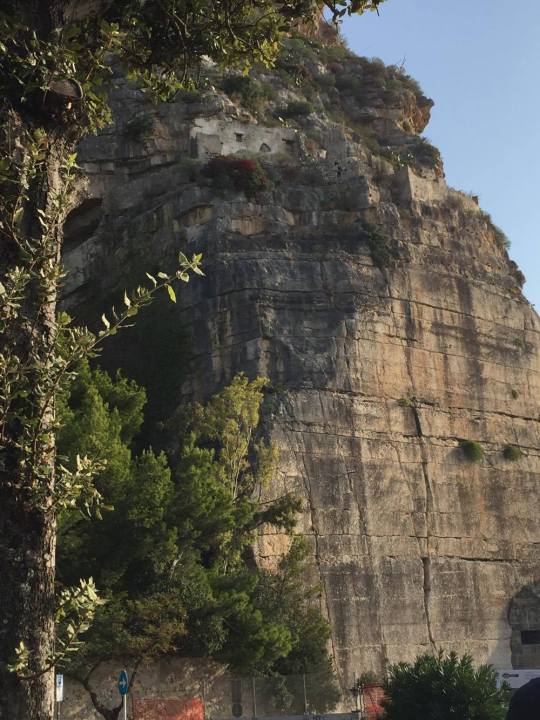
At the base of the cliff on which the temple sits, notable because it’s not actually a natural cliff. About two thousand years ago, give or take a century or two, the Romans decided that going around the mountain took too long, so they just…. moved the mountain. Carved it flat and made a passageway. If you look closely at the cliff you can actually see Roman numerals that were carved into the rock to indicate how much was cut away at that point. At the highest point, 120 ft of stone was removed.
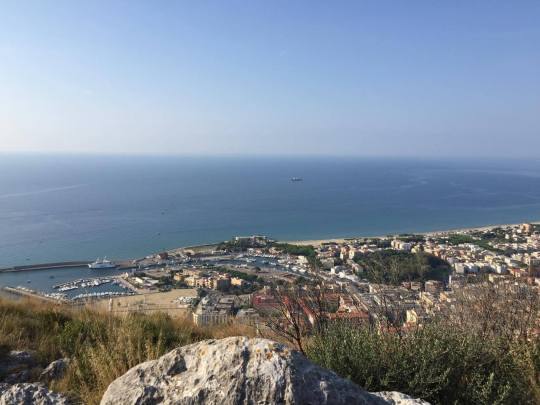
Terracina and the bay of Naples from the temple, because it was stunningly beautiful.
There is no photograph of the actual temple, I’m afraid, because there was no way to get a good picture from the base of the cliff, and no way to capture everything when we were wandering around inside. Google Terracina Iuppiter Anxur if you’re curious.
Following Terracina, we headed off to the Villa of Tiberius.
CRASH COURSE IN VILLAS: There are two kinds of villas. You might think that there are three kinds of villas. You would be wrong. The two kinds of villas are called villa urbana and villa rustica. Neither of them exist within the boundaries of any ancient city, because villas are, by definition, country estates. If it’s a house in the country, it’s a villa. If it’s a house in the city, it’s a domus at best. The villa rustica is essentially a farmhouse. Rustic, you might say. Like something one might expect to exist in the countryside. The villa urbana is like if you were a very rich person and could pack up everything that you liked about being in a booming metropolis of a city like Rome, and then stuck it in a house in the countryside so that you could feel free from city woes. There is an absolutely hysterical genre of poetry written by Roman poets who think that they should be able to tell you how to live in the countryside and ‘rough it’ because they happen to have access to a house that is, in the most basic sense, in the country. Lots of stuff about how to farm written by dudes who have, once, glanced out of their gilded window frames to observe a slave in the field across the way. Go read the Georgics (Virgil, pre-Aeneid. Don’t get me wrong, fantastic political commentary in that poem, but in no way is it actually about “agricultural things,” even if that is the Greek translation of the word georgic.
Villa culture was, essentially, about flaunting wealth, and reveling in your own status as a highly educated member of the elite. You built the houses to have massive libraries and statuary and a view of the ocean, so that you could roll around in your own cultural and intellectual heritage in front of the fishes, and generally prove that you were better than everyone else.
Anyway, the Villa of Tiberius. Tiberius was emperor after Augustus, and got the entirely unenviable task of trying to convince everybody that emperors were a good idea (Augustus never technically declared himself emperor, you know?) and also trying to sort out the mess that happens when there are no rules because one single genius invented the entire government structure and ran it by himself for forty five years and then died without telling anyone how he did it all. I do not begrudge him his gorgeous villa, if only because he deserved a place to get some R&R after years spent trying to drag a reinvented governmental system from the hands of a dead man.
The coolest part of the villa (both figuratively and literally, actually) was the natural cave in the cliff wall that the villa was built next to. The base of the villa opened onto the ocean (you can not buy beach front property this good today, my friend), but the entire left side extended into the cave, and incorporated a gorgeous series of tide pools, both natural and manmade. This cave was the crowning jewel of Tiberius’s villa, and included several incredible sculptures that now live in the museum next to the villa’s ruins.
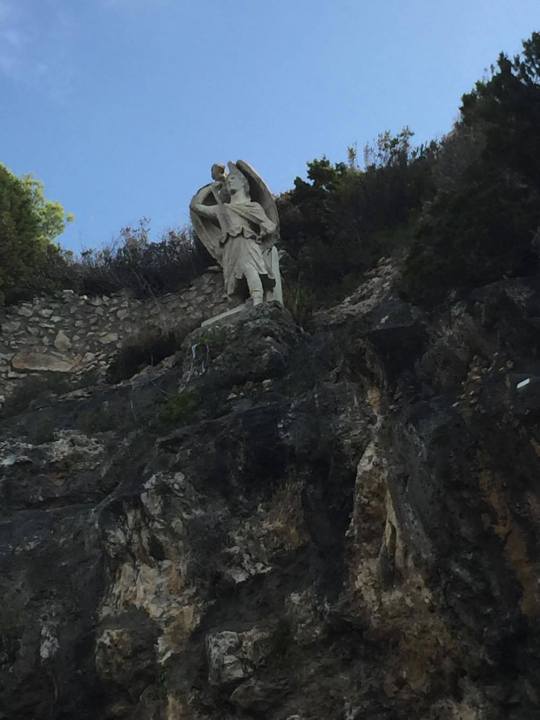
Statue of Ganymede, above the cave’s entrance. Looks like he’s got wings, but he doesn’t, actually, this is a statue that depicts the precise moment that Zeus, having looked down across the mortal world and seen Ganymede and thought Wow Pretty, sent an eagle to abduct him. For those of you who don’t know the myth, Ganymede is literally so attractive that Zeus makes him a god on Olympus. Just for being pretty. He’s Zeus’s cupbearer. If you thought people were joking about how very startlingly gay Ancient Greece was, you would be very wrong.
To be clear, there is nothing heterosexual about this story. At all. Zeus did not make Ganymede a god because he was lonely and wanted a good buddy to josh around with. Just. To be abundantly clear. Very very homosexual feelings all around, here. I say this because I once had someone tell me, to my face, that there was no way ancient Greek gods were actually gay. My dude, you have no idea.
(I mean, more accurately speaking Zeus is just very, very pansexual (or bisexual, depending on your preference), but this particular story is just super gay.)
Also, for those of you clever cookies who noticed that I’m not using the Roman name, good for you. The Ganymede myth does exist in Rome, he’s called Catamitus and was abducted by Jupiter, but this sculpture is pretty definitely Ganymede, because the theme for all of the sculptures in the cave was hellenism (or How Greek Can You Be: Roman Edition), but I’ll get to that later.
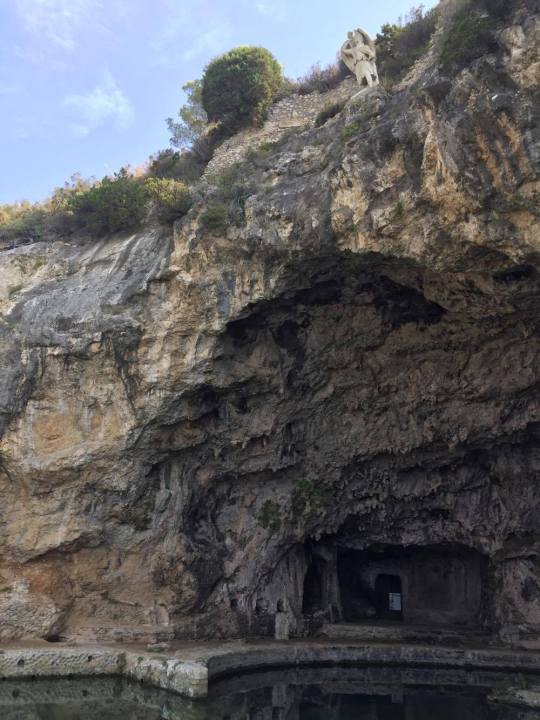
More cave! You can see the Ganymede sculpture all the way up at the tippy top. It’s a recreation, also, the sculpture is, the original is in the museum to preserve it. Most of the floor of the cave is taken up by a tidal pool, too, and you can see all the way in the back a carved out portion, and what looks like a door, and a glowing white square next to the door. For size reference of just how large (I hesitate to call it gigantic, only because I know there are caves that are much, much larger, but it was big to me, okay?) the cave is, I am about as tall as that glowing white square thing in that cut out room. Yes, I’m bitter about that. Moving on.
Another angle of that same cut out room, now inside the cave. You see what I mean about the floor, yeah?
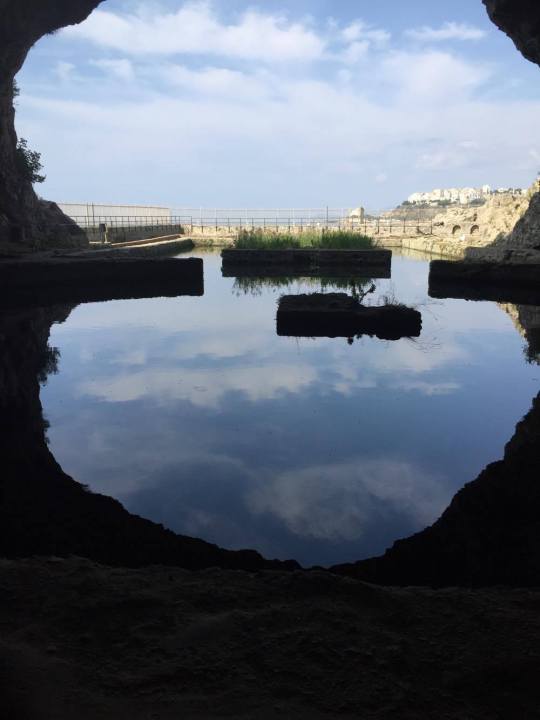
From the back of the cave. There was a large space behind me, of course, and there were those cut out rooms, but most of the cave was taken up by the pool. The theory is that there would have been a bedchamber area and a dining area in these cut out spaces, so that when the weather was too warm Tiberius could retreat to his cave house and live comfortably.
As you can see in the background, that whole area on the left where there doesn’t appear to be any sign of human habitation is the ocean. Honestly, if this were my villa, I would probably never leave. Screw running Rome, I want to sit in my cave beach house and read from my enormous library and have my servants bring me whatever I want. Sounds like a good life.

Now we get to the museum, and an artistic rendering of the cave statuary as it probably stood. That beautiful still glassy pool wouldn’t have been empty, not in an emperor’s house.

You’ve already gotten the spiel about letter E, Ganymede, so let’s move on to C, all the way in the back there (where I was standing to take that cave mouth photograph, actually, though that means almost nothing to you).

A recreation, of course, we don’t have this entire thing, but we have enough fragments and enough literary sources describing it to thing that this is pretty close to the original. This is, in all his alcoholic glory, Polyphemus, the cyclops from the Odyssey, who captured Odysseus and his men in his cave to eat them. Odysseus disagreed with that plan of action, for fairly obvious reasons, and thus got Polyphemus drunk, stabbed out his only eye with a burning stake, and then hitched a ride on the undersides of Polyphemus’s sheep (poor guy was a shepherd) in order to get out of the cave without being noticed (Polyphemus was blind, see, not dumb, so he felt the backs of his sheep to make sure that none of his captives rode out on them. He didn’t think to check the underbelly of the sheep because who rides on an underbelly? Nobody, that’s who). As one does. He also told Polyphemus, as he left, that his name was Nobody, which is why none of the other cyclops came to the rescue when Polyphemus shouted for help, because Nobody was attacking him.
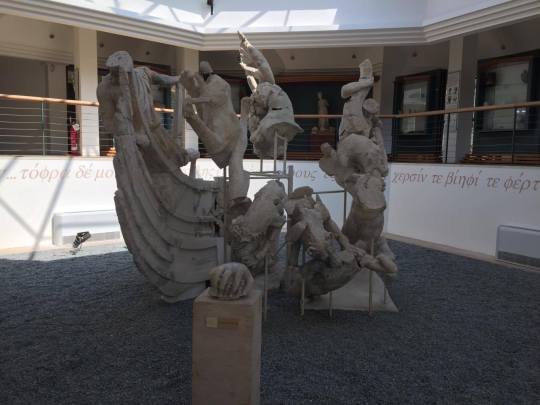
This is B, from that little drawing up there, though it doesn’t really look like all that much. It’s made from the fragments that we have, rather than being a reconstruction, like the Polyphemus scene. It’s from the Odyssey as well, later on in the story, when Odysseus’s ship must pass by the cave of the monster Scylla. Scylla is a sea monster, who has dog heads instead of legs. Yeah. Not dog /legs/ instead of legs, or a dog head instead of a head, but dog heads, multiple, for legs. I’ll let you figure the logistics of that one out, because honestly I have sat through an entire class where twenty classics students, plus our classics PhD professor, tried and failed to understand how exactly that might work. Horrifying? Yes. Very confusing? Also yes. Something that it is very difficult to make a statue of? Also also yes.
This particular scene is of Scylla taking men directly from Odysseus’s ship to eat them. With her human head? With her dog heads? Who knows! Not us! We don’t want to!
We’re missing most of the figure of Scylla, so you’re just going to have to imagine a beautiful woman somewhere in the center of the piece, somehow emerging out of all of those dogs. Also, that hand in the front there is supposed to go on the prow of the ship, we think, but that doesn’t fit the reconstructed image at all unless the artist just threw all of anatomy out of the window when he made the piece, which is not a thing to rule out.
Interestingly, the sculpture is, apparently, made by the same workshop in Rome that crafted the fairly famous sculpture of Laocoon and his sons being eaten by two giant sea snakes. There is a theme in this workshop’s work, can you tell?
Neither of the other two statues were intact enough to take photographs of, just a fragment here and there. However, we know that D, from the drawing, is Odysseus and his bro Diomedes stealing the Palladium of Troy, which was a little statue of Pallas that represented the safety of Troy.
Interesting story about Pallas time! So, while most people associate the name Pallas with an identity of Athena, as in Pallas Athena, that wasn’t the original Pallas. She was a nymph, a friend of Athena’s who trained with her when they were both young (relatively speaking, seeing as Athena was never technically young, she ‘sprung from Zeus’s head fully formed’ which is also a mental image that you really don’t want to think too hard about), until one day Zeus looked down, thought the two of them were fighting instead of training, and distracted Pallas with his shield in the clouds long enough for her to pause, and for Athena to accidentally put a spear through her heart. Athena was devastated, created a likeness of her friend and placed it in Troy so she would not be forgotten, took on the name Pallas Athena, and also declared herself an eternal virgin, by the way, because that is a totally rational reaction to the death of someone who is definitely just a friend. Ehem. Anyway. That statue was stolen by Odysseus because he has no sense of the sacred, so that the Greeks could defeat Troy without their guardian spirit. The Palladium was then moved, some say, to Rome, and placed in the Temple of Vesta in the Roman Forum, to keep Rome safe.
The final statue, A, on the left of the diagram, is a bit of a mystery. It’s two figures, one of whom is dressed in greek armor circa the Trojan War, we know that. The current theories are either that that is Menelaus holding the body of Achilles, or Achilles holding the body of Patroclus. I prefer the second interpretation, honestly, both because I like that story better, but also because according to the Iliad Menelaus didn’t even like Achilles, and I’m pretty sure the myth has Ajax getting all weepy over his body, not Menelaus. I don’t even know where we got the idea of Menelaus from, honestly, because it doesn’t make sense narratively. Also, there are so many statues of Achilles dramatically holding up Patroclus’s body and looking like his world is ending (which it is) that it just seems more plausible that it’s them.
All of these scenes from the Odyssey and the Iliad do actually have a purpose being in the villa of a Roman emperor, by the way, for all that they absolutely also represent the best of Greek legendary history. The villa is built next to the mountain Circeo, which is supposedly the mountain where the sorceress Circe lives, whom Odysseus visits and is enamored by for a full year (anyone who wants you to feel sorry for Odysseus taking ten years to get home clearly has no idea what he was doing in those ten years, honestly), connecting this place in historical memory to the idea of Greek travel and Mediterranean exploration, a thousand years before Rome became a superpower. The statuary is both Tiberius’s way of proving that he is very educated, because to be educated was to be familiar with Greek works, in that time, but also paying homage to local traditions, and retaining the Greek background that all of Rome is simultaneously enormously proud and very ashamed of. The relationship between Greece and Rome is very big sibling/little sibling, where the little sibling becomes enormously successful in life and the older sibling’s accomplishments, impressive though they might be ordinarily, fade to the background in the world’s eyes, but in the eyes of the little sibling they’ll always be. Well. Their older sibling. It’s one part reverence, one part hatred, and a whole lot of uncomfortable familial feelings that few people ever untangle without the help of a very, very good therapist.
After the Villa of Tiberius, we stopped in the unbelievably adorable little town of Sperlonga for lunch. I cannot overemphasize how beautiful this place is. Entirely made of tiny little streets that don’t allow cars? Check. Built of that beautiful white stone that glows in the ever-present sun and makes you feel like you’re wandering through a castle in the sky? Check. Flowers spilling out of every window box, and overhanging trees and vines providing both riotous color amidst the gleaming white buildings and much needed shade? Check. Absolutely breathtaking view of the ocean from the cliffs that it is perched on? Check. 10/10, would go back just to gape at the sheer gorgeousness of the place.
Following lunch, we got back in the bus and drove until we hit Naples, and the Archeological Museum therein.
I typically don’t…. Well, it’s not that I don’t like art museums, I appreciate them in a general sense as cultural conservation, and in certain moods I enjoy walking through them. I just tend to get distracted when looking at something purely visual for too long. It’s why I also do other things while watching TV and movies. So I go through art museums pretty quickly, and as long as I’ve glanced at everything, I feel like I’ve successfully taken everything in. It’s probably why I am the worst person to go to an art museum with, just in general.
(Books, by the way, in no way count as purely visual objects, and I can happily read a book for hours without getting distracted, but that’s reading, not looking.)
However. If there were ever a museum that I could lose a day in, it’s this one.
We covered quite a bit of material, mostly on hyper specific things (-and this is the scrollwork from the top of one of the columns on one of the temples on the Capitoline hill, note the beginnings of Ionian influence in the for the most part standard Doric structure-) that I feel like would not be particularly interesting to you, and in fact are not particularly interesting to me, mostly because that particular lecture tended to be geared towards the art history class, and not my Roman history class, but there were some great pieces of statuary that I want to note.
First, there were the simply exquisite pieces from Rome’s south east bath complex.

This is a multi-figure piece done in a similar style as the Scylla and the Laocoon pieces I’ve mentioned before, depicting the story of Dirce, a woman who insulted another woman named Antiope, who just happened to have two sons Amphion and Zethis, who got upset at the insult and, as you can see, behaved in that totally rational and calm way that all Greeks and Romans are known for, and punished Dirce by tying her to a raging bull in order to be trampled along the streets of Rome. Fun times.
This sculpture would have been featured at one end of the bath complex, and at the other would have stood a statue of Hercules. We saw that statue, significantly larger than lifelike, as well, though I neglected to take a picture of it. The statue is of a single figure this time, and is called Hercules at Rest, because he’s just kinda standing there, leaning on his club. He looks kinda tired. Me too, buddy, me too.
The statue is significant particularly because it represents a shift in focus in the Greek and Roman art world, from Classical to Hellenistic. In classical style, heroes and gods are typically depicted doing heroic things. Hellenism focuses more on the humanity of heroes and gods, and tends to show them doing rather uniquely human things, like leaning on their clubs to catch a break because just because you can carry the world on your back doesn’t mean you should, Hercules.
Another feature of hellenistic design, and one that makes this my favorite era of ancient art, is that the sculptures take great delight in hiding things in their designs, so that one has to observe the entire piece to get a full understanding of the story being told here. In the case of the Hercules statue, my professor instructed us to walk around to the back of the statue to “see what you observe.”
As the statue was both very large and also not wearing pants, we were all…. mildly alarmed at his suggestion, to say the least. However, we are also sheep, so we dutifully trundled around to the back of the statue to look.
Behind his back, Hercules is holding something. Three round somethings that, back when the statue was painted in its full glory, would have been done in gold.
The presence of the three golden apples, hidden so casually in the statue’s slumped over posture, gives this Hercules at Rest a definitive place in the timeline of the myth of Hercules, and also explains the need for the rest in the first place. Hellenism is about humanizing heroes, sure, but they’re still heroes, and the artist knows that. Even heroes get tired, but heroes get tired from doing things like holding the literal weight of the world on their backs and stealing impossible, Trojan-war-starting prizes from dragons in the gardens of goddesses.
In summary, a good statue.
My least favorite statue, by the way, was this one:

I do not like when the statues have eyes. I just don’t. Why would you do that. She’s going to come alive and murder everyone in this museum. You’re going to have that on your conscience, unnamed dude who thought that five of these were good decoration for his entryway.
(Unnamed dude was actually pretty cool, he owned the House of the Papyri, a villa that was discovered and named for the number of papyri preserved in its library. The statue is one of the Danaids, who were fifty daughters of the king of Danaus, who married his daughters all off in one fell swoop to a fellow king named Aegyptus who happened to have fifty sons. Due to unclear circumstances, the fifty daughters all killed their husbands, all on their wedding night. Except for one, who was clearly just a coward or something. Anyway, there were statues of all fifty of the daughters in Augustus’s temple on the Palatine, and this unnamed homeowner decided to copy his emperor’s super creepy taste in artwork. He was actually probably fairly close to Augustus, at least as much as anyone was, because in his library he had a book dedicated by Virgil himself, and everyone knows that Virgil was Augustus’s bestie. As much as anyone was.)
There was more, so much more, in the museum of Naples but frankly this post is already over four thousand words and I am fairly sure that no one cares about my unhealthily strong opinions about the styling of various Roman emperor busts, so I think I’ll take my leave here.
We left Naples and headed to a hotel in Paestum, called Poseidonia, which was very lovely apart from having a super weird bathroom set up. I may have flooded the bathroom. Just a little bit. There’s just no wall? There’s a little square of tile, with a lip, theoretically to prevent the water from going anywhere, but then the shower head points out into open space and all that the lip on the floor does is block whatever water the shower sprays around the bathroom from getting back tot he drain and long story short I flooded the bathroom a little bit.
But then the hotel was thoughtful enough to provide me with a really delicious gluten free dinner and so all is forgiven really.
#travels#rome#museum#I have forgotten what other tags I might need to use here#I suppose I can add them in later#also I was informed that people wanted to read my blog and perhaps even missed reeading it so no one is allowed to complain about the fact#that it's entirely too long and mostly about Roman art that's just how my life goes okay
1 note
·
View note
Text
Sunday, September 3rd 2017-Thursday, September 14th 2017
Classes! I go to classes now! All the time! It’s very tiring! Here is what they are:
Italian Film: Mondays for three hours and Tuesdays for an hour and a half. We’re watching movies in Italian (obviously) with English subtitles because we are pathetic Americans who cannot speak perfect Italian yet. The course is an English course, so we write a journal entry for each film, and also something of a sociology course, so we talk about what the film suggests about Italian culture in each of our journal entries. It’s also something of a history course as well, because the subject matter of the films tends towards Italian history. I really appreciate that particular aspect, because while I know quite a lot about ancient Italian history, my knowledge of modern Italian history is essentially it existed? It’s a boot and it’s in Europe and it exists? Though apparently it doesn’t actually exist, or didn’t always exist, and in fact has only existed in its current form for less than 150 years? The United States is technically older? Even if Italy has Rome and all of that ~Roman~ stuff? History is wild.
Anyway, we’ve watched neorealism films about WWII, Anni Difficili and Roma Città Aperta, and a non-neorealism film (because is wasn’t filmed in the direct aftermath? Apparently that’s the distinction) about WWII, La Vita è Bella, which has been more successful at making me utterly horrified, sickened, and completely broken as a human being than any of the films I’ve possibly ever. (Except for Pixar films which don’t count because they cannot be measured on traditional scales of emotional devastation.)
So far, the films have been really interesting, and no one has had a dramatic and pointless affair with a douchebag yet, so that’s very promising as far as I’m concerned.
Italian 1: Mondays for two hours, Wednesdays for two hours. I have. Less to say about this class. It’s a language class. It exists. I’m learning the Italian language. There’s not much more to it? My professor is very intent on us learning by doing, so there is not a lot of note taking and not a lot of explanations for why we’re saying what we’re saying, which is not really my preferred method of learning, but it’s okay.
I understand more than I can say, so far, and I understand possibly more than there is to understand, because Italian is a horribly simplified version of Latin. Like. There are only two genders? Three ending groups, in two genders? Like? Where are the five declensions and three genders that don’t mean anything because after the first two declensions they can be any gender but also mean everything? And as far as I can see things are modified for plural and singular and then just? Not? For anything else? Where are the cases? Are you telling me that every other language that I could have taken in high school did not have five declensions with different endings for both the singular and the plural of six possible cases, with three different genders that are almost entirely unrecognizable from the root word unless you memorize them by rote? What is this fudgery? And that’s not even getting into the verbs. Do you have any idea how complicated Latin verb conjugation is? Please, please, google image search Latin Verb Conjugation, and recognize that that first chart, yes, that one, the one with 138 different endings for a single verb is only the chart for the 3rd conjugation i-stem verbs and that there are four conjugations with a variant in the third, which makes five conjugations with 138 different endings for each one which makes 690 different verb endings only some of them aren’t different some of them are exactly the same as others but mean totally different things because ANCIENT ROMANS HATED ME, ME SPECIFICALLY.
Anyway. So. Yeah. Italian is not as complicated as I was lead to believe by Other Language Courses and that offends me personally.
Also I can’t tell whether no one else in my class is trying to get the pronunciation and the accent right, or if I’m just gifted or whatever, or maybe I sound as godawful as they do, but can’t they hear the difference in the vowels? They say things with such a horrible American accent that the word is literally incomprehensible and I genuinely don’t know if they don’t feel like saying it right or if they can’t. The professor doesn’t correct my pronunciation so I assume I’m getting it right, and that what I’m hearing myself say is what I’m actually saying, but in that case why can I hear the super clear and obvious differences, and they can’t? These are the kinds of questions I might ask if I was utterly lacking in social awareness, or actively wanted to be hated by my entire Italian 1 class. I am not, and do not, so instead I’m bumbling around in confusion on this blog post.
Italian Renaissance: Mondays for an hour and a half, Wednesdays for an hour and a half. The professor opened class the first day with a forty minute lecture about how this course should actually be called Dante through the Renaissance, because Dante was the most important writer in the history of Italy and also probably the world. I genuinely can’t read the word Dante and not hear it in her voice.
She’s a lovely person, though. Been teaching the class for forty years, likes to sit with us and rhapsodize about the beauty of even the translated version of the Inferno. We’re going word-by-word through each Canto right now, but it is a beautiful text, and I’ve always been a fan of obsessive close reading, because I am very good at obsessive close reading (Latin Poetry Strikes Again), so I’m totally on board.
Also Dante’s being led through hell by Virgil, and hey! I’ve read the Aeneid! I’ve read the Aeneid so many times! Do you know how many times?! I have five different copies at home! Half of them are in the original Latin! I am a nerd with no life! So that’s nice. If I ever get stuck on an essay question I can just draw on my vast knowledge of what Aeneas liked having for breakfast (pietas and divine purpose), and exactly how Virgil invoked the muses (differing, by the way, from the Greek tradition of invoking first and asking questions later, something that Dante eventually followed, if you were wondering).
Ancient City Rome: Monday for an hour and a half, Wednesday for an hour and a half. Awesome class. I mean, for the first thing, I already know at least a bit, because I took a class called The Romans last semester which, you know, covered a bit of Roman History. Just a bit. I’m one of the only classics majors in the course, so the professor picks on me, but at least I sometimes know the answer, so that’s convenient.
The professor is also great. He was the professor of one of my most favorite teachers from high school when she was a student here, which is very cool, and he’s apparently still in contact with her because he knew me from her, which was also cool. (Thanks for that, by the way. I doubt it means he’ll go easier on me, but it does mean that he always remembers my name, which is nice.) He wanders around the class (and occasionally outside of it, like, just walks out of the room and continues to talk to us under the assumption that we’re paying close enough attention to hear him) and lectures, and has clearly taught this course enough to know it frontwards backwards and sideways, which in some professors means a very dry, very boring recitation that they don’t care very much about at all, but in this car means that his lectures both cover all of the information necessary, but also involves the interjection of excellent sarcastic quips like, “My life sucks,” and “Romans were assholes.” I agree, with both of those statements.
Sustainable Environments: Thursday for three hours. I have picked sustainability focused courses to fulfill science and technology requirements for my entire time in college, because apparently I actually know a fair amount about sustainability already. Probably what comes of going to an environmentally focused school for eight years. Apparently I absorbed more information there than I thought, or, rather, people who did not go to a school that had a class called Discovery for eight years know significantly less about sustainability than I thought. We really should be educating our children more thoroughly about stuff like this, people.
So I take sustainability focused courses, because I’m genuinely interested in the subject, but also after so many years of science AP classes I deserve to be in a science class where I already know everything.
This one is mostly an interesting lesson on the differences between sustainability practices in the United States and in Italy. Rome in particular is made up of so many ancient buildings that it’s practically impossible to make any new construction, so there’s no going for sustainable design. You have to weight that, though, with the amount of waste knocking down buildings to rebuild creates, as well as the fact that the buildings created hundreds of years ago, before the industrial revolution, are far more sustainable than those built during the 1900s. Of course, that is only dependent on the climate staying relatively the same as it was when the building was created, which is not at all the case, so you’re back at square one.
So that’s it. That’s my class schedule. Also, in case you didn’t notice, eight hours of classes on Mondays. Straight. Well, not actually straight, I go at nine and leave at eight, so eleven hours at school with eight hours of classes and one break near five.
Mondays are. Long.
#rome#movie review#book review#Dante's Inferno totally counts as a book#class review#sure let's use that that sounds like a reasonable thing to do#also let's not pay attention to how ridiculously confusing my date keeping has gotten#it'll all become clear at some point#to me as well as you hopefully#also look no food in this one#who said that this was turning into a food review blog?#well here have a class review blog#travels
0 notes
Text
Saturday, August 26th 2017- Saturday, September 2nd 2017
Hello! Hi! I’m in Rome! I’m a terrible person who hasn’t been updating anything at all, partly because I’m in school full-time now, and partly because I am a lazy person who fell out of the habit after I left London and never got back into it!
I’ve decided that part of my problem is trying to make some kind of weekly schedule because that’s just becoming an excuse to not work on it, so from now on updates will be sporadic and highly irregular! You’re welcome!
Anyway, Rome is beautiful, and hot, and everyone speaks Italian which is to be expected but also makes just walking to the grocery store an Adventure. A kind of exhausting Adventure that’s getting easier all the time, and will hopefully be a piece of cake by the time I leave in eight months.
I’m really hoping that’s true, because eight months is a long time to go being exhausted by grocery shopping.
I’m learning not to panic when they bark questions at me over the cash register, and to carry bags with me so I can gesture when they presumably ask whether I want one, and give as exact change as possible so that no one asks me for some number of euro that I can’t quite figure out.
It really is stunningly beautiful, though, which does make up for quite a lot of language-barrier panic.
We’re living in this building thing, that’s an old villa and made up of a bunch of buildings all nested in together and chopped up into little apartments, which means that it’s beautiful and old and covered in climbing vines and flowers, but also means that, due to the chopping up, we have no windows. Our doors do open onto a little terrace thing, which is nice, but currently it’s overrun with mosquitoes, and also leads directly to a wall, so there’s not exactly air flow. It’ll be perfectly lovely in about a month, but until then we keep the doors closed and the air conditioning on.
The apartment is two rooms, plus a little bathroom, to split between three people. There are three beds (one single bed, and a bunk bed) squeezed into one room, with about a foot and a half of space between the beds, where I and one of my roommates stay, and then there’s a bed in the kitchen/dining room area, where our third roommate sleeps. In our room, we’ve built a blanket for out of the bottom bunk to give the illusion of privacy, which is hard to come by in a space this small.
For two horrifying nights there were four people living here, because a fourth roommate was mistakenly transferred into our rooms, and during that time my original two roommates and I discovered that while we once thought the space was terribly small was totally manageable with the three of us. We bonded in adversity, and when the mistake was rectified and our fourth roommate (who was lovely, really, it’s just that there was no space for her things and only three sets of dishes and forcing someone to live on the top bunk just seemed cruel but we’d already spent a week sleeping in the other beds) was moved to her rightful apartment, we emerged stronger as a whole.
Aside from that little adventure, orientation week was pretty standard. Lots of dull ice breakers, lots of warnings about the danger of living in Rome that, as far as I can tell, is about as dangerous as living in Philly, or London, or any other major city. Don’t be stupid, pay attention to your surroundings, try to always be around enough people not to be murdered, but not enough people that you’re in danger of getting your pocket picked without noticing.
The most interesting thing was on the last day, Saturday, when we spent the whole day at a castle.
Well, okay, ‘whole day’ might be exaggerating. It was a fair bus ride to get there and back, after all.
Anyway, we visited a little town called Todi a little north of Rome that was adorable, and spent the morning wandering around there. I found a bookstore, and bought the first Harry Potter book in Italian, because I have a collection of first Harry Potter books, and I’ve found that it’s a great way to learn a new language. I have, you see, at some point in my life, apparently memorized the first book, which means that I can figure out what’s going on even if I don’t actually read the language.
Here are some photographs of Todi, which is a town on a mountain and just as gosh darn cute as it seems from these very little glimpses.
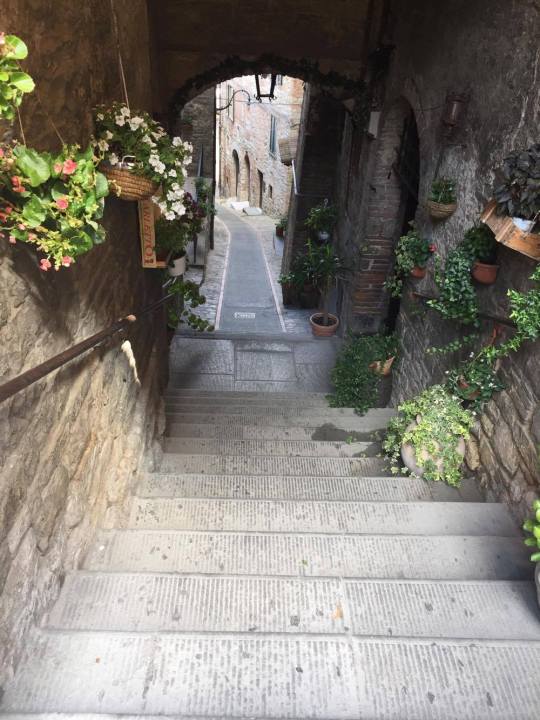

And this is the view from the village down into the valley.

I also got a palmier. It was delicious.
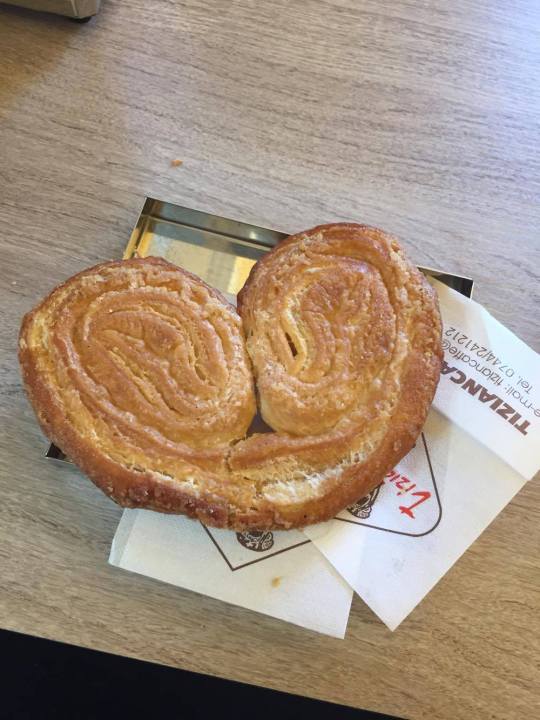
After Todi we went to a castle to have lunch.
I’d marked down that I wanted a gluten free lunch, which pained me to do because I was sure the bread must be brilliant there, but the bus trip was four hours long and we’d already gotten an email warning us about how winding the road to the castle was, I did not like the idea of having a tummy ache the entire drive back.
Turned out that it was a great idea, because after we arrived and found the courtyard where we were supposed to have appetizers in, one of the chaperones directed me to a waiter holding a platter that she handed to me and then left me alone. Apparently I was the only gluten free person on the trip, and that entitled me to my own personal platter of yummy things, while everyone else had to fight tooth and nail against 160 other students for the one buffet table.
The platter did have gluten free bread on it, which is from hell and should never be willingly consumed, but the bread was covered in really interesting things, so I braved the sawdust.

The chopped tomatoes on bread and slice of cheese was their substitute for the pizzettas that everyone else got, and while typically I would like I’d gotten the short end of the stick, but the tomatoes are delicious. I don’t even like raw tomatoes, but they were incredibly good.
It’s not fair. Tomatoes aren’t even native to Italy, they’re New World crops, like potatoes and blueberries and turkeys, but they tastes so much better here.
The other toppings were, I think, olives (not bad, didn’t really taste like anything? But too oily to be comfortable), something to do with pepperoni (tasted really good, but the texture was just wrong), liver (tasty, but what is with the Italians and pureeing perfectly good food? It’s such a weird texture?), egg (did not taste good, I think there was some kind of seafood in them, or maybe it was just the relish they used, but it was bad), and sausage (very good, probably because it wasn’t pureed. Here that, Italy? Things can taste good without putting them in a blender!).
Gluten free bread still tastes like sawdust, but it was sawdust with really tasty toppings, for the most part.
We went inside, then, to a gorgeous dining room with massive long wooden tables, enough for all 160 of us.
I was relegated to the Dietary Restrictions table, where one half was vegetarians, and then the two lactose intolerant people, and me. It was nice, we bonded over being Outcasts and having mildly weird dinners that always came out after the rest of the people got their food, and they liked me in particular after I mentioned that I was allergic to alcohol and thus would not be partaking in any of the bottles on our table.

First course was prosciutto, and some weird version of quiche (like phyllo pastry layered with soft cheese, I think) that for me was replaced with another tomato and more mozzarella. And more gluten free bread, which was disgusting and not pictured because no one needs to see that. The prosciutto and the tomato and mozzarella were all delicious, though.

Next course was asparagus risotto, which was creamy and wonderful and my new favorite food. Risotto, that is, not asparagus.

Third course was a very particular kind of long, wide noodle with a very specific name that I do not remember, in a wild boar sauce. My noodles were gluten free, and yummy, and the sauce was great.
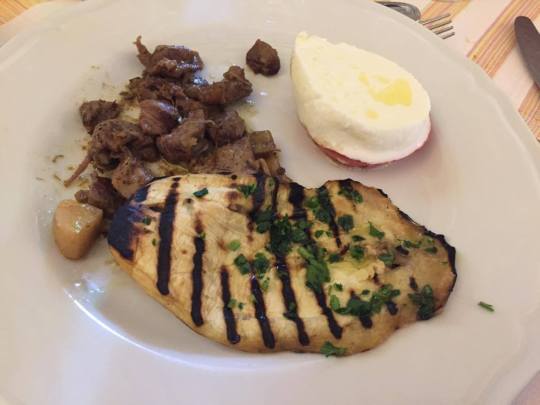
Third, fourth, and fifth courses could, due to the changes made by my ‘dietary restrictions,’ all fit on one plate. That’s venison (wonderful), more tomato and mozzarella (I don’t even know what that’s a substitute for, they just kept giving me more tomatoes and mozzarella, every time I turned), and paper thin eggplant that was delightful.
The next course was another selection of meat, either lamb or chicken, and potatoes, but by that point I couldn’t have eaten another bite.
Dessert involved cookies dipped in dessert wine (couldn’t eat that) and tiramisu (also couldn’t eat that, and wouldn’t have wanted to, because I am offended by the concept of soaking cookies or cake in anything, let alone coffee and rum. It’s not a nice texture, if you want to flavor it with brandy and coffee make a rum and coffee cake, or make a ganache, or put it in the cream, or do anything that isn’t soaking it. Why.), but I wasn’t particularly hungry for it anyway, so it was okay.
The road back was just as winding as they warned us it would be, but luckily enough everyone else fell asleep and I don’t get motion sick, so I just got to look out of the window and see the pretty views all the way back to Rome.
#rome#food#more updates to come I swear#this time it won't take half a month probably#I can tell you all about the classes that I'm taking#that are taking up all of my time at the moment#super fun times though#really Rome is so pretty#everything is old because nothing can be built here because of historical reasons#so it's all super old and lovely and there are trees everywhere#travels
0 notes
Text
Saturday, August 19th 2017-Friday, August 25th 2017
The house that we were staying in in Scotland contained one (1) kitchen scale, and zero (0) cups, teaspoons, or any other American measuring device. This is the first time I’ve ever used a kitchen scale exclusively. I have only this to say: I love it and I want one as soon as possible.
I made scones, using the scale, which involved measuring out all the ingredients like they do on a cooking show, which I really enjoyed.

Just look at that! So clean! So neat! So organized!

The scones came out well. I used a recipe from the BBC, which produced nine scones. As you can see, I put chocolate chips in three of them, as a test.
(If anyone looked at that photo and thought I’d put raisons in my scones, I would like you to exit from this website, close your computer, go outside, and eat small spoonfuls of dirt until you understand why putting raisons in anything is a terrible decision.)
The chocolate chips weren’t bad, though British chocolate chips are tragic and terrible and milk chocolate instead of bittersweet, which means that they add too much overall sweetness and not enough chocolate to the scone. It’s also why they’re not great for brownies. Overpoweringly sweet.
Later that night, I also made lemon curd, which was an Adventure.
This was neither neat nor clean.

Zesting and squeezing four lemons with neither a zester nor a lemon juicer is not for the faint of heart. The little grater was the best thing I could find, and it wasn’t nearly as comfortable to use for long periods of time as a microplane. There was also no sieve, so I used that very small tea strainer on that plate over there to take out the seeds and as much of the pulp as I could. That tea strainer is very small. Four lemons produces a lot of juice. It took about fifteen minutes, and I still wasn’t completely happy with the consistency.
The recipe was also from the BBC, and was interesting, because it’s the first curd or custard that I’ve made that involves whole eggs, rather than just yolks. This one was three whole eggs, and then a single yolk. I’m not sure about it.
If I’d had a larger strainer, I also would have taken out the zest after I cooked it, because while it gives the curd a sharper lemon flavor, and a good edge of bitterness to balance out the amount of sugar, it’s not a fantastic texture.

Still, it was a good curd, which is a relief, because there was a lot of it.
Paired well with the scones, too.

Other things that happened in Scotland:

I went to the beach. It was beautiful.


Went on a walk. Saw some sheeps.
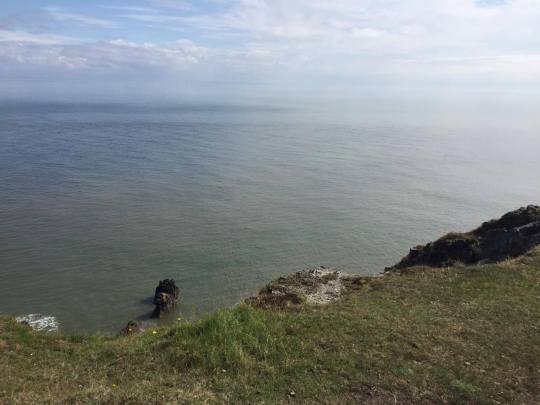
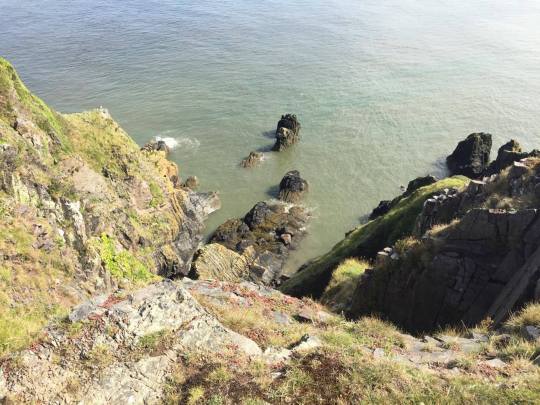
Saw some cliff.


Saw some horse.
We drove back from Scotland on Wednesday, a quick sixish hour drive, and ended up in an airB&B about three blocks away from the house that I stayed in during the program. Great bit of luck, that, because my mom and her husband were traveling home a good couple of days before I was to leave, and this meant that I wouldn’t get horribly lost while I was on my own.
We got excellent Indian food that night from one of the many places that I'd walked passed for about two months and never actually gone in.
Thursday, I took my mom to the Foundling Museum, so that I could have a second opinion about the excellence of the place. She agreed with me.
I also got to take a closer look at some of the art that I skimmed over last time, as I was busy taking notes on the history for class. I was most amused to discover two Roman busts, overlooking the conference room, that had evidently been there for several centuries, long before the place had stopped being an orphanage.

The first, of Marcus Aurelius, made sense, as Marcus Aurelius was a well respected and successful Roman emperor, whose death is often cited as the end of the Pax Romana, and the beginning of the decline of the Roman Empire. He’s literally known as the last of the Good Emperors.

Caracalla, on the other hand, was a significantly more confusing choice. He was.... less of a good emperor, complete with massacres enacted against his own people, and the murder of his own brother, and ended his reign rather quickly, dispatched by his own bodyguards. (Not an unusual occurrence in Ancient Rome, actually, the Praetorian Guard killed a significant number of emperors, many of whom they actually recommended for the job in the first place. No one, by the way, ever sat down and thought that perhaps the Praetorian Guard should be disbanded at any point in time. Ancient Rome was such a mess.) The only reason I can think of to choose to put Caracalla's face anywhere near an institution for children is because after he became emperor he took on the name Marcus Aurelius, and the decorators got confused.
He also has a neckbeard, which should really have tipped them off that he was the Bad Emperor, because the Bad Emperors always have neckbeards. Check out Nero.
We also went to have tea at Harrods again, which was just as lovely as the first time. They did not believe me when I told them that the tea was more than enough to qualify as dinner, but they ate their words.
I ended up falling asleep at about three in the morning that night, which was actually fairly early for me, due to the influx of terrible decision making by yours truly happening recently (the real reason nothing interesting happened in Scotland was because I stayed up until five and woke up at twelve every day), and then I woke up at six thirty in the morning to say goodbye to my mother and her husband and make sure they'd packed the books that I needed them to take home for me because I had no room in my luggage. I waved them off, they left for their taxi, and I promptly went back to sleep.
The rest of my Friday was spent taking a long walk through Hyde Park and, now that no one is around to judge me, falling back into my old habits of gluten free noodles and tea for dinner. Look, I’m sure I’ll learn to feed myself healthy at some point this year. For now, you’ll just have to accept that I ate grapes along with the noodles. And the tea. It tasted good to me, okay? (Dative of possessor, to me, mihi.)
#london#scotland#that very last parenthesize is because that's what happens in my head every time I say to me#Latin has ruined my internal monologue with /grammar/#it's not even /English/ grammar#because I don't /know/ anything about English grammar#anyway this is the new format I suppose#I do care what you think#so let me know#though I don't know how much I'll change because this is so much easier for me to write#travels
0 notes
Text
Wednesday, August 16th 2017
Okay, so here’s the thing: I didn’t do anything.
I mean, I did, I wrote most of a twelve page final paper, but that’s it.
I’m not sure what to tell you.
I went into a fugue state and emerged with a paper on tracking the concept of childhood through the literary relationship to the parent. That’s what I did.
So, you know what, here’s the paper, because I don’t have anything else to talk about for today or for tomorrow:
The purpose of children’s literature, first and foremost since English became a written language, was education. In order to be functioning members of adult society, children were taught to read as expediently as possible from ABC primers and, after their mastery of the alphabet and the basics of the English language, were plunged directly into the Bible. The purpose of reading was to be productive in their future careers. Enjoyment of their preliminary texts was not considered even a remote priority, and efficiency was key. Children’s literature consisted of school books, and little else (Avery, 5-7). “The aim of schoolmasters… was not to inculcate a love of literature… but to drill their pupils in the language, using a very limited number of texts” (Avery, 10). Childhood existed as nothing more than a preliminary step before adulthood, where one was to acquire the necessary skills required of an adult. As the concept of childhood as a separate identity to adulthood grew, however, the children’s literature industry grew with it. The understanding of what this stage called childhood meant is traceable through the interactions between the child and the parental figures within the narratives of both children’s books and books about children.
The first real change came in the sixteenth and seventeenth centuries, with the Protestant Reformation. “All men are full of evil lust and inclinations from their mothers’ wombs… This inborn sickness and hereditary sin is truly sin and condemns to the eternal wrath of God all those who are not born again through Baptism and the Holy Spirit” (Luther, 29). Martin Luther’s proclamation suggested that not only were all people inherently evil, but those in most danger were children, as they were unable in their infancy to express a love of God, and therefore save their souls. Childhood became, rather than the first step in life, a landmine of danger and immorality, from which one could only hope to be rescued as soon as possible, in order to understand the grace of God and save their soul before an inevitable, untimely death. “The child’s nature was determined by original sin… Children were ‘savages’, awaiting the education that would transform them into civilized adults” (Briggs, 169). The goal of the writers of children’s literature, therefore, was transformed from simply ensuring their literacy in a world that was increasingly dependent on the written word to ensuring, from the very earliest age they could manage, that the souls of children were purged of sin as quickly as possible.
Into the world of the Reformation James Janeway introduced his highly successful book, A Token for Children: Being An Exact Account of the Conversion, Holy and Exemplary Lives, and Joyful Deaths of Several Young Children. As the title indicates, the book features the lives of thirteen children as they find God and come to understand their inherently sinful nature, redeeming themselves and saving their souls before they die. His first story, about a little girl named Sarah Howley, revolves around her relationship with God, beginning at eight years old. Her childhood is entirely taken up with attending church and leading a productive life. “She was very Conscientious in spending of time, and hated idleness, and spent her whole time either in praying, reading, instructing her little Brothers, and working at her Needle” (Janeway, 57). Her job is to act as much like an adult as possible for a child, as this action would save her soul.
The role that Sarah’s parents play in her story is a tangential one, for though they are present and active in her life, praying for her when she asks it of them, and giving her as much support as they can, the book makes it clear that Sarah’s religious transformation was by necessity her own doing, and could not have been coerced by any other person. However, there is an overwhelming parental presence guiding Sarah throughout the story. “Her Father bid her be of good cheer, because she was going to a better Father” (Janeway, 58). In this sentence is the one of the only times her father is directly mentioned, as her mother is primarily responsible for helping her through her convalescence, which makes the parallel drawn between her parents and God all the more pronounced. The parental figure of God reigns supreme, directly responsible for every decision and action she makes within the story, and stands in judgement of all that she does at the end. The acceleration to adulthood that she experiences renders her parents somewhat obsolete, but brings an aggressive prominence to the parental role of God in her life.
As Sarah leaves behind her childhood of original sin, she also becomes a parental figure for her younger siblings. “She got her little Brother and Sister into a Chamber with her, and told them of their condition by nature, and wept over them, and prayed with them and for them” (Janeway, 57). Her role in instructing them in the ways of the Lord on numerous occasions, and convincing them to follow her example in religious devotion, is that of an authority figure over them, as she has become their superior in her newfound adulthood. Her act of praying over them is paralleled with her parents’ praying over her as her condition worsens (Janeway, 58-59).This is also an illustration of the purpose of Janeway’s novel, that the story and the life of Sarah should instruct other children to follow in her example, in order to live a more godly life. Sarah teaches her siblings as the metaphor of her teaches all of the readers of Janeway. As childhood is demonized in the Reformation, parental figures are glorified, and are centrally important to children’s literature, to the point where even the child protagonists act as parents.
As the Reformation gave way to the Age of Enlightenment, the beliefs about children being born with original sin gave way to beliefs about children being, evolutionarily speaking, inferior to adults (Briggs, 169). This belief, that childhood was a primitive state that was then transcended in order for the child to reach adulthood, did little to change the ultimate understanding of childhood as inherently lesser, and necessary of adult guidance at all times. The next true change in views came with the Romantic Age, and the advent of imagination.
While in Janeway’s time to not be working productively at all times was a death sentence for the soul, during the nineteenth century play and games began to be regarded not as idleness but as reasonable things for a child to be engaged in. “Many adults actively encouraged children to enjoy themselves… [Books] were imbued with a sense of responsibility and duty, but with an increasing capacity for warmth and laughter and imaginative enjoyment” (Butts, 101). The idea that childhood was not merely an annoyance that one must grow out of, but an important life stage in which happiness should be encouraged, as well as learning, brought forth a new era in literature.
William Blake’s Songs of Innocence contain several poems referencing this new way of thinking about childhood. Including poetry about children in a collection called Innocence is in and of itself a sharp contrast to the beliefs, religious and scientific, of the previous two centuries, that tend toward the vilification of childhood and the demonization of the child. The introduction itself establishes the fact that though the speaker in the poem is an adult, the songs are inspired by the inherent innocence of a child, in a direct contradiction to the concept of original sin being most present in childhood. “And I wrote my happy songs,/Every child may joy to hear” (Blake 4). In this way, Blake directly links the concept of innocence, as it appears throughout his poetry, to the idea of the child, even if he is not directly writing about children.
“The Chimney Sweeper” in Songs of Innocence is a poem that does directly involve children as more than just a metaphor for an innocent and naive understanding of the world. The speaker of the poem is a person of an indeterminate age, looking back on his interactions with the protagonist of the poem, Tom Dacre, a child chimney sweep. As the voice speaks in past tense, it is unclear whether he himself is a child, but he is certainly older than Tom, and acts as in a parental role towards Tom, guiding him through the dangerous world of the chimney sweeps. In this poem, Blake both condemns the actual parental figures, who sell their children to chimney sweeps, as well as the religious stand-ins that James Janeway so praises in his Token for Children. “The Angel told Tom, if he’d be a good boy, / He’d have God for his father & never want joy” (Blake, 12). Blake’s Angel withholds God’s parental love from an orphaned child whose horrific job will kill him long before he reaches adulthood until Tom meets the Angel’s conditions, namely that he behaves and does his duty until his duty inevitably puts him in a coffin. The speaker of the poem, Tom’s mentor, has already learned this lesson, and passes it down to Tom in the last line, “So if all do their duty, they need not fear harm” (Blake, 12), which is also a condemnation on the part of Blake, towards forcing children to grow up too quickly and take on the role of teacher to those only slightly younger than themselves, perpetuating a cycle of abuse. The acceleration of childhood from Janeway’s time, which made a parent of Sarah Howley as a prerequisite for her ascension into heaven, is called into furious question by Blake as part of the new beliefs about importance of childhood in the Romantic Age.
“The Chimney Sweeper” from Songs of Experience continues this line of questioning. “A little black thing among the snow: / Crying weep, weep, in notes of woe! / Where are they father & mother? Say? / They are both gone up to the church to pray” (Blake, 37). The parents are criticized for effectively selling their child into slavery because the child was “happy upon the heath” (Blake, 37), which is also a statement on the importance of happiness in a child’s life. During Blake’s time there was a newfound appreciation for imaginative play and games within the life of the child, which Blake supports in this poem, instead of the old tradition of putting an ‘idle’ or ‘lazy’ child to work. The parents are also criticised for the prioritization of religion over their child’s wellbeing, and the church is criticised for its view on raising children. According to the “little black thing” in this poem, the church “make up a heaven of our misery” (Blake, 37), here meaning that they profit on the backs of children, and the assume that the children are benefiting from it. Again, the exact things that Janeway prizes in his book are, less than two hundred years later, reviled.
Though Blake does defend the child’s right to have fun, and argues against parents who do not allow their children to experience a full and complete childhood, he does so with the voice of an adult. The speaker in the introduction to Songs of Innocence is an adult taking advice from a child, the speaker in the first “The Chimney Sweeper” is an older and more experienced person, and the speaker in the second “The Chimney Sweeper” is an adult who has stumbled across a child in the snow. Blake was not writing for children. “Songs of Innocence reached few if any children of the time; hand engraved and printed by Blake and his wife, they were never intended for the commercial market. Indeed, Harvey Darton, writing in 1932, said that it was only recently that Blake’s spirit had become ‘a living spark in poetry meant for children’” (Avery and Kinnel, 67). He was concerned for the welfare of children, but he was speaking to the adults responsible for the children, rather than having anything to do with addressing them himself. While childhood, in Blake’s time and through Blake’s influence, was beginning to be transformed into a time of innocence rather than a time of sin, adults were still entirely the gatekeepers for the child’s world, and the parent was of utmost importance.
The end of the Victorian Era and the brief Edwardian heralded the start of a new philosophy on childhood. “The figure of the child lent itself to idealization, since it appeared to possess vitality and spiritual insight as yet uncontaminated by adult desires… the energizing animal spirits and impulsiveness associated with sexuality, while not yet being driven by it” (Briggs, 167). The child in the Edwardian Era was a pure and perfect being, antithetical to the amoral child of the Reformation. Instead of believing that the ignorance of the child meant that they were automatically on the wrong path, and by necessity had to be guided to virtue and good by the adults in their lives, the child’s ignorance according to Edwardian tradition was proof that they had not yet encountered the corruption of the adult world. Interaction with adults became less and less encouraged as the idealization of childhood insisted that at the first introduction of adulthood, a child would fall. It was a stark change from the hastening of childhood in earlier centuries, in order to pull them out of the way of original sin as fast as possible. Edwardian conclusion was that it was best that the child remain a child for as long as possible, to preserve that purity of mind (Briggs, 173). It was this notion that gave birth to the famous childhood hero Peter Pan, the boy who never grew up.
J. M. Barrie’s work began as a commentary on the prevailing literary themes in children’s books in the early twentieth century, though the titular character did end up becoming the face of Edwardian ideology. In Peter Pan in Kensington Gardens, Peter is so young that he has not yet been touched by humanity yet, let alone adulthood. He flies away from his nursery window because he has not yet forgotten that he is not a bird. “The moment you doubt whether you can fly, you cease for ever to be able to do it. The reason birds can fly and we can’t is simply that they have perfect faith, for to have faith is to have wings” (Barrie). This perfect faith is part of the purity that the Edwardian Era insists belongs to children. When Peter remembers that he has a mother, he loses the ability to fly, because in thinking of the adults in his life he no longer has that perfect faith. He remains trapped on the island, neither entirely bird nor entirely human. Barrie does not glorify Peter’s agelessness in the same way in this original story in the same way that later productions would, but points out that by remaining forever in this perfect childhood state, Peter forfeits his humanity, and most of all forfeits his right to live among other humans. He spends his life lonely, on the island, restricted from going into Kensington Gardens, but never quite fitting in with the fairies and the birds that live on the island either (Barrie).
There is uncertainty in Barrie’s work, however, for as lonely as Peter’s life on the island is, when he is offered the chance to go back to his mother, he hesitates, and ends up waiting so long that he loses his place there. In this way, Barrie illustrates a second point, about the parents’ role in this new version of childhood. Throughout the first chapter, which is ostensibly an introduction to the setting of Kensington Gardens, the narrator speaks in second person, addressing children directly, from the perspective of a nursemaid whose job it is to shepherd a child, David, around Kensington Gardens. She knows the mind of the child, and describes the garden as a child would. “In the Broad Walk you meet all the people who are worth knowing, and there is usually a grown-up with them” (Barrie). The nurses with the children are referenced quite often, but the parents are distant figures mentioned only in passing, as the ones who set the naptime schedule that restricts the child from wandering around the entire park as they please. If Barrie’s first social criticism is that children should be allowed, in their time, to grow up, this distance is his second, that the distance that parents put between themselves and their children, in some misguided attempt not to spoil them, is a painful thing to bear. Peter’s heartbreak when he attempts to return to his mother only to discover that he has been replaced by a new child is tragic (Barrie). Barrie’s commentary is the exact opposite of Blake’s, though their final conclusion is the same: that the dehumanization, either by idealization or demonization, of the child is a dangerous act, and hurts society as a whole. Extreme parental distance is just as damaging as too much oversight.
Modern texts are working their way to a happy medium between these two extremes. While parents appear in Maile Meloy’s The Apothecary, their presence is not intrusive. They linger comfortably in the background, assisting the children as they need, but the narrative puts the life and voice of the children first and foremost. The book is told, as the introduction explains, from the diary of Janie Scott, the adolescent protagonist, which makes this the first story told explicitly from the perspective of the child (Meloy, 1). She and her friends are not entirely self-sufficient, and must make use of information provided by adults, but are allowed to make their own choices and their own mistakes. The first person perspective, told in the present tense, throughout the book emphasizes the agency given to Janie. There is no parental oversight in the voice, not even an older version of herself looking back on her life and judging her own choices. Accordingly, theories about childhood during modern times tend to revolve around the idea of supervision, but not suffocation, of the child in question (Konner, 736).
The parents’ role throughout children’s literature, particularly when it comes to the speaker’s voice, is elemental in defining what childhood is. As childhood becomes more idealized, the parental voice grows distant. The authority of the parent is central to the life of the child, and the way the child is understood is central to how the parent uses their authority. Janeway and Meloy both present texts that agree with the common understanding of the parent’s role in the child’s life, while Blake and Barrie write reprimands to society about being more conscious of how their decisions affect their children.
Works Cited
Avery, Gilian. “The Beginnings of Children's Reading.” Children's Literature: An Illustrated History, edited by Peter Hunt, Oxford University Press, 1995, pp. 1–25.
Avery, Gillian, and Margaret Kinnell. “Morality and Levity.” Children's Literature: An Illustrated History, edited by Peter Hunt, Oxford University Press, 1995, pp. 46–76.
Barrie, J. M. Peter Pan in Kensington Gardens. Charles Scribner's Sons, 1910.
Blake, William. Songs of Innocence and of Experience, edited by Andrew Lincoln, Princeton University Press.
Briggs, Julia. “Transitions.” Children's Literature: an Illustrated History, edited by Peter Hunt, Oxford University Press, 1995, pp. 167–191.
Butts, Dennis. “The Beginnings of Victorianism.” Children's Literature: an Illustrated History, edited by Peter Hunt, Oxford University Press, 1995, pp. 77–101.
Janeway, James. “From A Token For Children.” From Instruction to Delight: an Anthology of Children's Literature to 1850, edited by Patricia Demers, Oxford University Press, 2004, pp. 56–60.
Konner, Melvin. Evolution of Childhood: Relationships, Emotion, Mind. Belknap Press of Harvard University Press, 2011.
Luther, Martin. “The Book of Concord: the Confessions of the Evangelical Lutheran Church.” The Book of Concord: the Confessions of the Evangelical Lutheran Church, translated by Theodore G. Tappert, Fortress Press, 1959.
Meloy, Maile. The Apothecary. Puffin Books, 2013.
#london#scotland#I don't even know what to tag this#college paper on children's literature?#sure that works#you're welcome I'm sure everyone here wanted to read three thousand words about child lit#travels
3 notes
·
View notes
Text
Tuesday, August 15th 2017
The breakfast part of the Bed and Breakfast was just as delightful as the rest of the house, complete with a cereal and tea service, as well as a full English breakfast.
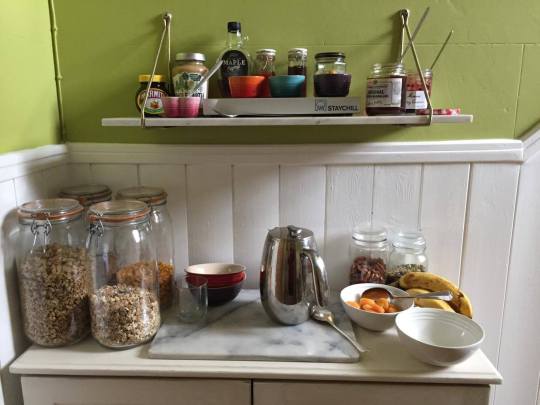
Just look at those lovely green walls. Aren’t they gorgeous?
After breakfast, we had a couple hours before we had to clear out, so I finished up the first Lord of the Rings movie, and took copious notes, which included the following:
Rather inexplicably, “This entire movie is just the weirdest game of peek-a-boo ever imagined,” which I’m sure has a secret meaning that only a rather exhausted Trixie in the morning would fully understand.
The sudden influx of death and destruction and arrows being stabbed into important organs is really alarming while I’m eating breakfast.
Frodo determinedly rowing off very slowly because he’s a small peanut in a big boat while Sam, who is equally small and unwieldy on the water, stomps after him is a great scene. Honestly, me too, dudes, me too.
Clearly Sam should carry the ring, he’s been directly in its presence countless times and hasn’t tried to mess with it once. He really, really doesn’t care.
Okay, so a dwarf, an elf, and a human walk into an army- gosh, this entire movie is just the set up of a bad joke.
Also a terrible plan.
This entire movie is a bad joke and a terrible plan.
That is my final review. Great movie, but godawful planning skills from all of them.
I then, of course, discovered that the next movies in the trilogy were not available on Amazon Prime, and fell into despair.
Well, fell into despair for about five minutes, after which I had to pack and dress and leave, because we were supposed to check out.
My mother and her husband went for a walk around the mountains in town, while I found my way to a coffee shop to work on my second final paper.
While I was walking there, incidentally, I passed this hilariously well-named shop:

How very, very true.
Around lunch time, we reconvened, and headed to Scotland.
I slept most of the way, and read the rest, until we arrived in Castle Douglas, the larger of the few towns near where we were staying.
There, we loaded up with groceries (evidently, my bag of flour and coco powder didn’t count as proper food supplies), from the butcher (I’ve never been in an actual butcher?), and the grocers (which sells vegetables and fruit and not much else?) and the organic food store, where I discovered gluten free rice cakes with dark chocolate on top, which is my new favorite snack.
In the grocers, I found a section with rather hilarious candy:

The Stating The Obvious

The I’m Alarmed That This Exists

The What The Heck Is This Supposed To Be, Because As An American I Have No Earthly Clue

The This Is What Hell Looks Like
We also got fish, being sold in a parking lot out of a van by a Fish Guy, which is apparently typical for a Scottish coastal town.
In Philly, knock-off t-shirts and weird trinkets (and other things) are usually what’s being sold out of the back of vans.
After shopping, we drove the last couple minutes to our house.
By which I mean, of course, we got lost up three different back roads and ended up in a cow pasture, someone else’s barn, and a private mansion before we found our cottage.
It was worth the wait, though, because it’s adorable.

Also a minute’s walk from the shore.

Stunning.
#london#though I suppose it's actually#scotland#I should probably start separating out those tags#but I really don't feel like it#travels#food#movie review#this really is the most gorgeous place#and perfect weather too#by which I mean only rarely sunny and generally about 60 degrees F#which is just perfect in every way
3 notes
·
View notes
Text
Monday, August 14th 2017
I spent the hours between midnight and three trying to pack everything that I brought to live on for ten months away from home and also everything that I’d managed to collect over six weeks of living in London which included, but was not limited to, eight fairly large books, several new shirts, a pride sash, a very small toy minion that was once the top of a kid’s movie snack cup, and more baking supplies than most people would deem necessary for a six week stint in a foreign country. It was hardly adequate.
I then sent a message to my mother that said something along the lines of I am setting an alarm for eight in the morning, but if I don’t have a message from you telling me to be out of the door by eight thirty, I am going back to bed and resetting the alarm for ten.
I sent that, and then went to sleep.
At eight, I woke up to a message telling me to go back to sleep, which I did.
At ten, I woke up and packed everything I forgot about the night before, and then hauled my suitcase, my backpack, and the three extra bags of things that I could not fit into my original luggage into the rental car, with my mother’s help.
I then proceeded to sleep for most of the five hour ride.
We got to the Lake District (my old enemy we meet again) in the evening, and were welcomed into the cutest B&B. It was adorable and brightly colored and the owner told us all about how she renovated the space with one of her sons, and how she was planning on writing the name of every lake she’d swum in on the stairs.
Just look at this gorgeous bathroom.

It has a tub.
I mean, I didn’t actually take a bath, because I don’t like baths, but I could have, which makes it a far cry from the very tiny box of a shower that I had been using in my London residence, which was literally not big enough to stick both elbows out in.
The room was also adorable, and my own, so I didn’t have to share with anybody, which was lovely.
We got dinner at a little restaurant that served excellent meat pies, and then my mother and her husband retired to their room to sleep, and I retired to my room to… well, not do that.
I actually was planning on sleeping, because despite the fact that I’d spent most of my day asleep, I was still exhausted. Finals week plus traveling to a new country for a whirlwind weekend adventure does not lead to healthy sleep habits.
However, at about ten at night I discovered that the first Lord of the Rings movie was available on Amazon Prime UK, and that seemed like an appropriate movie to watch while still in England, so I figured I might as well.
To be clear, I’d never actually seen the movie before, or read the books (I know, I know, a high fantasy book that Trixie hasn’t read? It’s a miracle! But seriously, I tried so many times when I was younger, and I could never make it past the first hundred pages because it dragged so much. I read the Hobbit, but the Lord of the Rings always eluded me. I might try to read them again, though, I think I could do it if I just powered through the boring beginning), and somehow I hadn’t looked at the time stamp, so I was a full hour in before I realized I’d committed to a movie that was four hours long (it was the extended edition, because of course it was) and by then I was far too invested.
I do believe I sent a message somewhere along the lines of WHO MAKES A FOUR HOUR LONG MOVIE AS THE BEGINNING OF A TRILOGY to friends that I knew had seen the movies before.
The rest of this post is going to be a ramble about my feelings on the first Lord of the Rings movie, so if you’d rather not read that, you can stop here, and I will certainly not blame you.
So first of all why, in every fantasy novel, do they introduce the people like the elves, who are perfect, and the dwarves, who are rich, and the humans, who are corrupt and definitely the first to fall in any here comes the evil scenario? People die soonest? It’s not that I disagree that people are the worst, it’s just that I don’t understand why everyone else can’t also be the worst?
I'm confused. The Power of the Ring makes him a jedi?
It's very unclear what the Power of the Ring actually is.
Like.
Mind control?
Telekinesis?
And does it pass on like the elder wand? You gotta kill someone to get it?
I suspect these are the things that I would find out in the books, but if I read all three of them (and the Silmarillion, thanks, I do know some things), and I don’t get a detailed description of what the rings are, what power they impart, how they got that power in the first place, how they were made (and if it’s hand waved as ‘magic’ that does not count), and what, precisely, it means to have the power to rule them all, I will dig up J R R Tolkien to demand answers.
Moving on: I’m sure Gollum was a super creepy character when he was first introduced but I’ve seen too many memes mocking the voice and the my precious line to take it seriously.
I understand why I loved the Hobbit more than LOTR: Hobbits spend their lives eating and reading and hating tall people, that’s clearly where I belong.
I also hope that the books contain a detailed explanation for what wizards are, how they get their power, why they’re all apparently old men, and what, exactly, their power set is.
Speaking of wizards, Harry Potter has negatively conditioned me to mistrust any old bearded wizard who says trust me, I'm your friend. Is Gandalf actually Sauron. I think I’d have gotten that spoiled for me at some point, but honestly I have surprisingly little idea how LOTR actually ends. I assume they win. Hopefully not a lot of people die but I don’t have high hopes about that.
Dementors on horses.
I realize that Harry Potter is basically a ripoff of LOTR, as most fantasy written since it was written is, but it’s my best point of reference for everything in life, so.
Okay, if your name is practically the same as the big evil guy, I feel like it should be a hint that you, too, are a big evil guy. Saruman, I am looking at you, dude. You were born to be very evil, and you didn’t even need to sit on that super creepy big black throne to prove it, though the fact that you did that anyway just proves that you’re one of the super dramatic big evil guys. Good for you.
It's interesting that, typically, in these sorts of books, people use magic to have physical fights. They're just throwing people around, but using magic instead of muscles. If they'd just hit the gym more often they wouldn't even need the magic.
I say that as a person who absolutely could not throw someone across a room without the use of a lot of magic.
Small dark haired plucky protagonists that look like Daniel Radcliffe should stop having such blind faith in old grey bearded wizards.
Sam yells, "Those wraiths are still out there!" and I heard, "The racists are out there!"
Honestly it would not surprise me to learn that ring wraiths are racist. They seem like the type? You know, malevolent, evil, wear hoods, like to gang up on innocent people and make their lives miserable, undead, probably trying to kill someone you love at any given moment, it makes sense. Also were once in power and are desperate to get it back and failing hard. Also probably living in the white house right now.
Lord Elrond looks like he's about to throw up every time he looks at someone. Anyone. Every person. What happened in his life to make him this extraordinarily bitter person. Is that one of those things the books would tell me?
"I am ready to go home."
-Frodo, with two and a half hours left in the first movie in his trilogy that might as well be entitled Frodo Doesn't Get To Go Home.
I feel like people who say that humanity's greatest downfall is pride are missing some key aspects of our personality, because personally I do not want to rule shit, thanks, and I don't particularly want whatever mystical power that ring holds over other people, it's clearly evil, throw it away please, but also if I were at that meeting I would absolutely want to poke the ring. I don't want to have it, or put it on, I just want to poke it. Curiosity to the point go stupidity is a much more interesting fatal flaw, and a much more accurate one for our species as a whole.
Elrond is hilariously offended to find out people were eavesdropping on his super secret meeting concerning the fate of the world in an open-air pavilion area.
I also believe that Elrond is evil, along with Gandalf, and everyone else, in fact, I trust Sam and everyone else has an agenda. Sam and Frodo. Maybe Merry and Pippin but that is it everyone else is the height of evil and someone should protect these hobbits from the rest of the world.
Why is everyone in every fantasy movie ever so willing and eager to make their last stand?
You know, the first Harry Potter movie was released about a month before the first Lord of the Rings movie, and I'm pretty sure that audiences everywhere that year were getting super tired of watching small dark haired plucky protagonists that look like Daniel Radcliffe be attacked by trolls while their equally plucky though typically more reluctant friends rescue them.
what fresh hell is that minotaur on fire
YOU SHALL NOT PASS has much more gravitas when it's not a mocking parody, I have found.
I was three hours in and decided to actually get some sleep, and finish everything up the next day because they were super peacefully floating down a river on some elven boats and I suspect, from the course of the movie thus far, they were not going to remain peaceful for any longer.
All in all, so far it's not a bad movie. Is my personal opinion. I know the entire world was waiting to hear my judgement on what is arguably the most famous series ever written (that isn't Harry Potter), and I judge it not bad, so far. Shocking that this massive phenomenon that has inspired the adoration of millions is actually good.
#london#travels#movie review#all in all this was a highly unproductive day but I really enjoyed that movie#and also that car ride was the height of relaxing honestly#a fantastic beginning to my vacation's vacation
2 notes
·
View notes
Text
Sunday, August 13th 2017
We had one goal for the day: Brunch. With mimosas.
Also the Leprechaun museum, but that came later. One goal for the morning: Brunch. With mimosas.
That was actually fairly difficult to do, because mimosas aren’t apparently a typical brunch food in Ireland, but my friends were very insistent that all they wanted was a mimosa, so off we went to (google) where we could get a mimosa brunch in Dublin.
We found a place downtown, so we cleared out of our airB&B, packed everything into the rental car, and drove off to find brunch.
Brunch was very good. I got American-style pancakes, with berries and clotted cream, because we’d eaten a lot of full Irish breakfasts at that point and I wanted something that was not-that, and water, because I don’t actually like mimosas. It has equal parts to do with the orange juice and the alcohol, really, because oranges are my least favorite citrus, and I don’t like alcohol. It smells and tastes like something that should not be consumed, and I don’t have a lot of strong feelings about trying to get myself to ‘acquire a taste’ for something that I have such an intense dislike for. And, to be honest, the last thing I tried to ‘acquire a taste for’ because people said I should was milk, and it turns out I’m lactose intolerant and it was a very good thing that I disliked the taste from the start because that probably saved me a lot of stomach aches.
That entire paragraph was just to hopefully get people to stop asking me why I don’t drink. It’s not a moral issue, it’s not something that involves a tragic backstory, I just think it doesn’t taste good, and that’s held true for every alcohol I have been introduced to. I’m happy to sit with my water or my lemonade and hang out with friends who are enjoying mimosas, though.
I also loved their drink menu, if only for the ghost pun.

This brunch was lovely, enough that we ended up spending two full hours there. Eleven thirty to one thirty. I would have felt weird about it, except there were like three other tables of people who were there when we got there and hadn’t left by the time that we did.
After brunch, we meandered our way to the Leprechaun museum, which was theoretically a ten minute walk from the restaurant, but ended up taking us over an hour because of every time we were hopelessly distracted from our initial quest.
All of our unplanned stops were fantastic, though, so it was all good.
First we found a market that had a variety of stalls selling, primarily, jewelry and souvenirs. It was great.

If I wore necklaces, I would have bought this necklace. Nothing like a fly face on your neck.

I really, really wanted this shirt, because it describes my every emotion all the time, but I could never wear it without feeling guilty.
We also got distracted in a sweetshop that I got a mint chocolate chip ice cream cone in and then watched while my friends spent fifteen minutes trying to find the perfect candy whistle that was also the right shade of blue to match one of my friend’s hair. It was an adorable little place.
Our third stop was on a bridge, so that we could take #aesthetic pictures of Dublin down the river. I am not going to put any of the pictures I took in this post, because they are terrible pictures if I do say so myself.
We did eventually get to the Leprechaun museum, and there I parted ways with my friends. They went into the museum, and I went across the street.
Did I go to a classic Dublin historical monument? No. Did I go to some relic left from a traveling Roman whose letters I read at some point? No. Did I at least go to a bookstore? … No.
It was an indoor shopping center.
Literally nothing special about it. I didn’t even know it was there before we got there, and I made a split-second decision to go there instead of the museum.
I don’t really have an excuse for that, except that it’s the most American place I’ve been in a while, and, to be honest, I’ve missed it.
I’ve spent almost two months in another country, and I’m gonna spend almost nine more in an even more foreign country. I’ve missed it.
There’s something very peaceful about massive spaces that are entire free of personal effects, where hundreds of people are rushing in every direction, who all have their own lives to live and their own places to go and who never have and never will care about the girl in the corner sitting at a tall, cold white table, eating an orange and reading on her phone. It might be capitalism’s stockholm syndrome working its magic on me, but there are few places that make me feel more comfortable than one like this, where I can sit at an ugly modern table drinking the exact same 7-up that I could get anywhere, while pop music that I could hear anywhere plays faintly overhead, muffled by the voices and ambient noise of people all trying to get somewhere that is not here. There were no distinguishable accents or languages in the hubbub, and I really could have been at any mall back home.
I had my quiet little introvert moment (and it’s funny, that I’ve always felt the most tranquil and calm in crowds like this, when being out in the open fields of the countryside so often makes me feel trapped and claustrophobic. I think it’s the city in me), and then, when I went to find a bathroom, I discovered an ancient pubic computer bank, and a printer, which was very lucky, as we were still trying to figure out how to print our tickets for the flight home.
I let my friends know that I found the printer, and they met me in the shopping center after they had finished with the museum to collect their tickets (and me).
After that adventure was done we had a bit of time to kill before we needed to head to the airport for our 9:00 flight, so we went to do a Proper Dublin Tourist Thing, that is, to see Dublin Castle.
It was very… nice. Very castle-like. My photographs of it also look kind of terrible, but that’s okay, because we only had time to see the courtyard anyway, and that wasn’t super interesting. But there really is just a castle. In the middle of the city.
This is what makes Europe so different from the US, because they’re just casually got these ancient fortifications lying around next to a McDonalds.
After the castle, we walked back to where we’d parked the car, all those hours ago, and drove to the airport.
Attempted to drive to the airport.
We drove in circles a lot.
Dublin is super confusing, to human beings and to GPS.
We did eventually make it to the airport, dropped off the car at the appropriate car rental place (you may find it odd that I specified that it was the appropriate car rental place but there were a couple close calls), and got through security with almost alarming ease. I’m beginning to suspect that my life as a traveling American has prepared me for much longer waits at airport security than I need to be prepared for in other countries. Good to know.
We did some poking around at the airport shops, most of which were closed, and then found our gate, which was in a dimly lit wing of the airport that required quite a bit of walking and a very long escalator to find, and there ended our weekend in Dublin.
Oh, also, I forgot to put in any of my last posts, but there was a pear tree in our backyard. With actual pears that were not ripe but it was super cool.
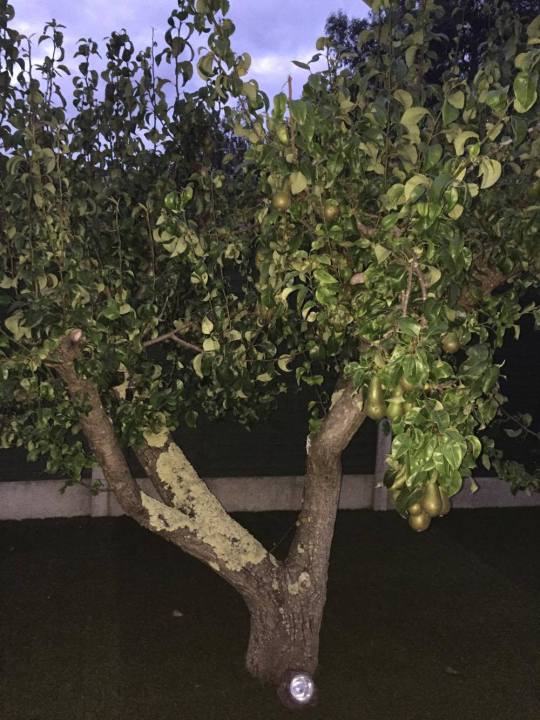

#london#travels#food#sure let's say that it's food#oh right also#dublin#I keep forgetting that I have Categories here and I want to keep them functional#the pears by the way were /very/ not ripe#as one of my friends discovered#there was also a crabapple tree out back#but no one wanted to try one and find out if they were ripe#for obvious reasons
2 notes
·
View notes
Text
Saturday, August 12th 2017
There was a plan for the day, to get up bright and early and leave by nine to go to Blarney Castle. This was the plan. It was a very good plan. Very well thought out.
Which means, of course, that by 12:00 nobody had left the house.
I was actually not planning on going to the castle at all. The castle, while an excellent idea, was three hours away, even with the rental car that we’d gotten that morning, and I’ve been to… a lot of castles around Europe.
But that’s getting ahead of my story.
One must remember that not only had we had a frankly exhausting day before that began at an hour thats mere existence proves that the universe is a cruel and unfeeling place, but we were coming off of a six week intensive study, as well as the week of finals for that study, so it shouldn’t be surprising that we wanted to sleep in a bit on our first real vacation, even if it might have impeded tourist activities.
It is my personal opinion that not all vacations have to involve seeing everything that a city or a country or a historical site has to offer. Sometimes vacations can just be sleeping as long as you want, eating good food, and spending some down time in a new and interesting place.
So we slept in, while one person went to get the car from the rental place and pick up some groceries on the way back.
When he returned, we tried our hands at making a proper English breakfast ourselves.


I’d say we were pretty successful, wouldn’t you?
The croissants were toasted in the oven so that they were pleasantly warm. One of us made bacon, and then fried the eggs in the bacon pan. I made sausage, as best as I could. At one point, I asked my co-chef how to know when the sausage was done, and she looked at me with mild panic in her eyes, and admitted that she’d never cooked any of this stuff before either. It was rather reassuring to know, actually, to know I was as skilled as anyone else there.
After a delicious breakfast, if I do say so myself, I shooed my friends out of the door to go see their castle, and did the washing up myself. It was rather relaxing, actually, though if either of my mothers plan on holding that statement against me I am taking it back right now.
The kitchen, by the way, is equally as IKEA as everything else in that house, but it was gorgeous, so it’s not like I was complaining. I will say that an all-white table looks very nice until you have to try to clean it, and then it’s just awful and I am turning into my parents, I realize, but I don’t actually care, because it’s true.


Look at that. So pretty, but the minute that you drip one bit of green dish detergent on those white cabinets they will never be clean again.
The dual fridges and dual ovens, though, I could live with that.
Doesn’t it look just like the IKEA show room?
Anyway, after cleaning up and doing a bit of googling, I headed out to explore Dublin on my own, with my trusty bus pass in hand.
By which I mean, of course, I took a lovely bus ride into the city center, and then I went to a bookstore.
It’s called Chapters, it’s the biggest independent bookstore in Dublin, and it’s lovely.
I restrained myself to two books (Dirk Gently’s Holistic Detective Agency, by Douglas Adams, and A Wise Man’s Fear, by Patrick Rothfuss, both fantastic, both that should be read immediately by all of you right now at once), but I spent a happy couple of hours wandering the shelves. They had a great classics section, including some books that were apparently written by that new spiderman actor, moonlighting as a classicist-
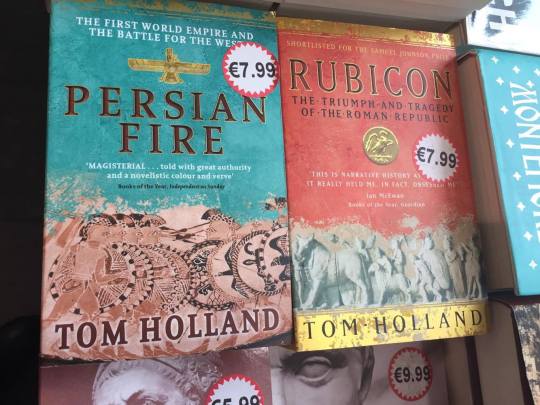
and also a book that I was very tempted by.

I ended my afternoon by searching out a grocery store to get the makings for grilled cheese, because despite being allergic to literally everything in a grilled cheese, I wanted one badly enough that I decided to just deal.
My friends arrived back home from the castle at about 1:30 in the morning, which made me feel much better about my decision not to attend. Also the big tourist attraction at the castle is kissing the Blarney stone, which involves being lowered out over a ledge high up in a tower of the castle by a man who’s job is to lower people out of windows, which must be super fun to explain to people, and apparently I would have been too short to do it. Lucky I didn’t try.
They did tell me about a poison garden that they visited near the castle, though, which sounded super cool. I want a garden full of poisonous plants. That sounds like an excellent idea.
(Apparently there was a marijuana plant in the garden. Purposefully planted there, though, not just someone’s pet project, which I assumed at first. It was in a cage to prevent people from… borrowing it for their own use. A genuine part of the poison garden.)
It sounded like they had a lot of fun, despite the six hour roundtrip, and I had a lot of fun doing my own thing at home, so it was a win-win for everyone.
#london#sort of but also of course#dublin#travels#food#book review#sorta I mean I recommended books didn't I#this was a good day#I like Dublin as seen from the front seat of the top of a double decker bus#really pleasant indeed
0 notes
Text
Friday, August 11th 2017
There is nothing good about waking up at 3:30 in the morning. Nothing.
We sat in exhausted silence around the kitchen table. I shared the last of my rice crispies with my roommate, because we needed to get something in our stomachs before leaving, but were so tired that we felt slightly sick.
We called a car at four, and got tot he airport by 4:45. I’m sure you’re very surprised to learn that there was practically no one on the road.
The car ride was also spent in silence, because everyone was too busy nodding off against the windows to make conversation.
There was a similar lack of people at the airport at 5:00 in the morning, so we got through security fairly easily. I think. I don’t actually remember that bit, but we certainly were all there past security when we found an open drug store where we could get sandwiches and wake up a little with second breakfast.
The flight was equally unmemorable. I assume I slept, or perhaps I simply stared at the ceiling for the amount of time it took. It was only about an hour, after all, so I really could have blinked and been there, practically, even without sleeping.
Our seats were near the back, all grouped together so that my entire row was people that I knew. That was very pleasant, made the whole did-I-accidentally-drift-onto-your-shoulder-in-my-sleep conversation at the end much less awkward. We disembarked the plane from the back as well, which was the first time I’ve done that. Walked down the steps right onto the tarmac. The stinging cold air of the Irish morning did a fairly good job of shocking me awake, as did the unusual route into the airport, which involved wandering past several planes, all of which were fairly…. distinctive.

I thought the four-leaf clover thing was some kind of rude American stereotype, but clearly I was mistaken.
We had no luggage to collect other than our carry-ons, so we made fairly good time out of the airport- until immigration.
My roommate, though from America, is a citizen of the EU.
(Well, actually, she’s a citizen of Britain, so no longer of the EU, but she’s still got an EU passport, is the important thing.)
She went into a separate line from us, and we all felt very guilty, staying together like this while she was all alone. That is, until it became clear that she’d waltzed through in about ten minutes, and gone on to find a comfortable seat to wait for us to stand for an hour waiting to be let into the country. Ugh. Is it too much to ask for a comfortable chair on wheels to carry me through the line while I take a nap? Is it?
After that, which was just lovely, really, we reconvened just outside the exit, and discovered that no one had a plan for the rest of the day. We spent a full hour in line, and never once did we think to have any sort of discussion about what we would do now that we’d successfully made it to the country. Perhaps we were all anticipating spending the weekend being detained by Irish immigration.
After a long conversation that mostly went something like:
“What should we do?”
“I’m tired.”
“We can’t check into the air B&B until 2.”
“Okay, so what should we do.”
“Is there anywhere we can nap?”
“…. We can’t check in until 2.”
“Okay, so what should we do?”
“…. Sleep?”
We finally decided to go find some traditional Irish breakfast, so that at least if we ended up sleeping the rest of the day away, we’d done something productive in Ireland beforehand.
We googled a place, found a taxi big enough for the five of us (which is very difficult to do, by the way, outside of the US), and asked him to take us there. About halfway through the ride, we also came to the realization that along with typically being smaller, taxis in Ireland didn’t take credit cards. Thus began a frantic search through bags to make sure we had euro, because of course they use a different currency. Of course Britain had to go and be special and not standardize its money, and make life hard for poor American students.
We found it, eventually, luckily several of our party had previously been in France during this trip and had enough leftover euro to pay the driver, but it was a traumatizing couple of minutes.
The breakfast place was lovely, and we had what I now realize was our third breakfast of the day. Neither my roommate nor I felt that we could finish a full Irish breakfast on our own, but the mini Irish looked very small, so we ordered a mini and a full, and then I gave her my toast and my beans, and she gave me her bacon and one of her eggs. Neither of us touched the black pudding. Our stomachs were still rather rocky from getting about two hours of sleep and then flying, so we were not feeling particularly adventurous, but several of our other friends actually tried it. Apparently it’s essentially like sausage patties, if they were overcooked and somewhat tragic. And looked terrible.
Of course, because we’re all very mature vaguely 20ish year olds, when we left the cafe and noticed a couple pieces of playground equipment in the area right next-door, we definitely did not drop all of our bags in a heap and sprint for the spinning spider-web cone. We definitely didn’t all get on and make one of our friends spin us on it, nor did we in any way nearly fall off because we leaned back too far and were caught off-guard by the effect of centrifugal force. We didn’t let our phones fly out of our pockets because we were stupid enough to do any of that with them tucked loosely into sweatshirt pockets.
And we particularly didn’t do that after eating a big, rich breakfast, when we were all feeling slightly queasy to begin with. Because that would be ridiculous. Completely and utterly ridiculous. Childish and silly.
Definitely not something that I would absolutely go back and do again without a second of hesitation.
After we did not spend an embarrassing (and very fun, no regrets, even with the topsy turvy tummy) amount of time playing with equipment definitely built for five year olds, we discovered that we could go to our airB&B earlier than two, so we took taxis again. We were far too tired to puzzle out public transportation in a strange city.
Our airB&B was divine, though, well worth the wait.
It appeared to be made entirely from IKEA showrooms, but I’ve always wanted to live in an IKEA showroom, so.
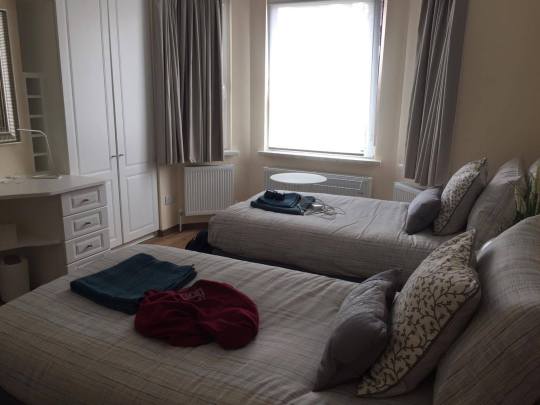
And I had it all to myself because there were enough bedrooms that only one pair had to share.
My room was also the only one on the ground floor, which meant that, though I did have the street right outside my window, and all the noise that that implies, I also had the kitchen right next-door, which was very nice.
We all took a short tour around our house, deemed it acceptable, and then promptly retired to our rooms for a well-deserved nap. It was around one in the afternoon.
“We’ll meet up at three!” we said. “We’ll all set alarms and be ready to go explore Dublin!” we said.
At about 4:30, I heard a few footsteps come down the stairs, and discovered that two of my four friends had roused themselves enough to come downstairs and make a lackluster attempt at looking through the collection of magazine clippings detailing the various restaurants that the homeowner recommended.
We can at least have dinner somewhere interesting, we figured.
Of course, there were no good restaurants around us, and we had very few euro left, so we had to either try to find a cab company that would seat five people and also take credit cards, or we had to find out how to use public transportation.
I figured that one out, actually, thank you very much. Apparently there is an extensive bus system in Dublin but, much like the buses in Philadelphia, they only take exact change. Which would be exceedingly difficult to come across for us, who had no european change. Alternatively, there was a bus card, like an Oyster card or a metro card or whatever the new Philadelphia transpass system is called, and it could be purchased at about 400 different sites around the city.
The only difficulty is that the website could not tell us where those sites were found relative to us, so I had to painstakingly type in each name into googlemaps and hope that one of them would be in walkable distance.
Fortunately, there was one, only about half a mile away, so I semi-confidently (I will never be absolutely confident with directions, never) led my group of starving, bleary-eyed friends to a place that I hoped would sell us Leap cards.

Aren’t they just adorable?
The place turned out to be a gas station that not only could sell us all leap cards, but had an ATM, which took a load off of all of us, to be honest. There’s something very comforting about having the correct currency when going around a foreign city for the first time.
The bus ride to the restaurant that my friends had found was lovely, and the restaurant was entertaining. It was a pub, technically, which usually means that you order food at the bar, but instead here you ordered food at what was essentially a buffet station, where all of the options were laid out in front of you, and you got to watch them carve off your slices of ham, or chicken, or what have you, and then hand your plate to another person who would dish up a vegetable and a potato of your choice. Ireland does not kid around when it comes to potatoes, by the way.
(Which is super entertaining, really, because potatoes were originally a ‘new world’ crop, so they’re not native to ireland at all. Just like how tomatoes are a staple of Italian cuisine despite being only introduced in the last millennia, after they made it to the ‘new world’ and figured out that those big, suspicious red fruits were actually edible. Food history is interesting.)
I ended up getting a shepherd’s pie, which was an excellent decision, because I love shepherd’s pie, and I hadn’t had it yet since I’d gotten to Europe.

A very excellent decision.
The food was great, the atmosphere was lovely, and the entire pub was crowded full of people for some sports game thing that I definitely did not pay any attention to.
My friends stayed longer, but I ended up taking the bus home to finish writing the paper outline that was due at midnight that day. The outline came together well, though, so it was a good end to an… interesting day.
Let me reiterate, though. Nothing is worth waking up at three in the morning. Nothing.
#london#even though it's actually#dublin#travels#food#there are very few pictures of this day not because there weren't things worth photographing#but because I was far too tired to take pictures when I should#still a great day by all accounts though really#I lied Ireland is probably worth waking up at three in the morning for#but very little else is
1 note
·
View note
Text
Thursday, August 10th 2017
Final film class involved an hour’s lecture on Brick Lane, followed by a series of one-on-one conferences about our final papers. As I’d already had my conference on Monday, and essentially finished writing my paper, I ended up switching my conference time to the very first slot so that she could get her check-in with me out of the way.
Apparently, that meant that she would ask me about any questions I might have in front of the entire class before they left to give the individual meetings privacy. It was. Not quite what I expected. I was rather relieved to only have a short question about the citation style, otherwise it might have gotten awkward.
Afterwards, I printed my paper, bade my waiting friends adieu, and went back home, fully intending to write up that second final paper outline and also maybe pack a bit.
Full disclosure: I took a nap.
I woke up from my nap at four-thirty, because of course I did, and a handful of minutes later my roommate burst into my room in a panic, because we were supposed to meet our professor for dinner down-town at five.
A bit of explanation, because I don’t think I mentioned: My friends and I decided to go to Ireland during the last weekend of our trip, because, apart from a farewell dinner on Friday, we had nothing else planned until the program ended on Monday.
Well. When I say we decided. I actually mean that I wandered into my bedroom a few weeks into the program, fresh off of one of my independent study field trips, to find my entire group of friends sitting scattered across our extra beds and chairs. They turned to me as one. “Would you like to go to Ireland at the end of the program?” they asked. I thought about it for as long as it took me to cross the room and toss my bag next to my dresser. “Sure,” I said. What else could I say?
I sat out of the preparations after that, for the most part, because my schedule tended to be different from everyone else, due to the independent study, which is why I’d forgotten to mention it until now. I actually forgot to mention it to both of my moms as well, until one of them actually came to London and asked about my upcoming schedule.
(She was planning to come to London, by the way, I didn’t force her to by not telling her anything about my life.)
Because we were missing the farewell dinner, however, we decided to take our teachers out for dinner on our last day in town, before the Shakespeare production of King Lear at the Globe that we were to see that night.
We ended up going to a great place, the George’s Inn, with our professor, who told us the history of the place while we waited for our food. Apparently, there used to be traveling players who would perform in the courtyard below the restaurant, while people eating dinner would watch from the balcony.
We had a lovely meal, and our professor asked us what we were planning on doing in Ireland, because he’d spent a year there when he was in college and was familiar with the area, and we looked at each other and then avoided eye-contact with him as we admitted that, though we were leaving the following morning, we had no idea what we were doing.
Personally, my idea of a perfect vacation, particularly directly after six weeks of school and writing final papers, involves a lot of sleep, followed by a trip to a bookstore or a library, perhaps some good food, and then a lot more sleep, but I elected not to mention that as my professor gave us a list of very interesting things to do around historical Dublin.
We left for the Globe rather early, so that our professor could be sure to meet our other classmates and hand out the tickets for the night’s performance.
I was very excited, as I’d missed the last Globe production due to illness, and also because it was King Lear, which I’ve never seen performed. Also, we got seats for this one, which was fantastic.

Outside the entrance to the theater. The Globe loves me, confirmed, clearly.

The set, which was, as you can see, entirely covered in what looked like dropcloths. The coverings were remove one by one throughout the performance, whenever a character had a particularly intense fit of passion, which meant that by the end of the night the full glory of the Globe’s stage was revealed.
I love the Globe theater, really I do. I’d always recommend at least going to visit, if not going to a performance, because it takes you back right into Elizabethan time. You know it’s the only building in London with a thatched roof? After the Great Fire of London, thatched rooves (yes that is a word, shut up autocorrect, it’s the plural of roof, and just because it’s not standard doesn’t mean it can’t be right) were outlawed for being too, well, flammable. The reconstructed Globe (because this is a reconstruction, a beautifully done reconstruction, but a reconstruction. It’s not even on the original site, because that’s now quite a ways away from the river’s side, so really it’s more authentic to have it placed in the new site on the new banks of the river rather than at the old site where it would be surrounded by office buildings) is the only building in London permitted to have a thatched roof, and that was only after a whole bunch of legal battles.
(When I say it takes you back to Elizabethan time, you needn’t remind me that in Elizabethan time the smell would be horrendous, because there were no such thing as public bathrooms, or garbage cans, that was what the straw heaped on the floor where the groundlings (the unwashed masses who payed the lowest amount for a ticket to stand near the stage) stood was for, which was likely just as awful as it sounds. You also needn’t point out that there were very likely far fewer planes flying overhead, and also there is a distinct lack of bear-baiting going on anywhere near the playhouse, which would really give it a boost in authenticity. Don’t bother mentioning, either, that there would be far fewer women in the audience, and none onstage. Trust me. I know.)
One of my favorite stories about the Globe that is almost certainly true, was long as you believe that Shakespeare existed in the first place, is that Shakespeare and his company played originally in a theater called, imaginatively, the Theater, which was located on the north bank of the Thames. Unfortunately, when their lease was up their landlord refused to let them continue there, and they were forced to take their business elsewhere.
They went to the Globe! I can hear you exclaiming.
Not quite.
Actually, they waited until enough people were looking the other way, and deconstructed the Theater in the middle of the night, carted it away down to the very last board, ferried it across the Thames and rebuilt it on the south bank, christening it The Globe.
Shakespeare was never prosecuted for the crime. I’d like to imagine he stared down any accusers who might dare to suggest that he would ever steal another person’s work. Leaning against the newly painted walls of his theater, he would exclaim, “Me! Steal a theater! I would never!” The people gathered around him would gesture furiously at the very, very obviously stolen theater that he was standing in front of. “This?!?” he would cry. “This is not the Theater! This is the Globe! My very own theater! I built it myself! Down to the very last board! It can’t possibly be the Theater! Everyone knows the Theater is on the North Bank. This is on the South!”
Then he probably went back inside to continue cheerfully ripping whole sections out of Plutarch’s Lives and stuffing them into Coriolanus and Julius Caesar.
Ehem.
Anyway.
Back to the present day.
Lear was fabulous, really. I’ve never seen it before, so I can’t be nearly as judgey about it as I was about Tempest and Macbeth, but it was very, very good. Which. I mean. It’s the Globe. That’s rather expected.
The actor playing Lear was particularly good.
I will say, though, that the play is rather incredibly long, and they didn’t appear to cut anything. I am talking a full, three and a half hour performance that began at 7:30.
Did I mention that the flight we were catching to Ireland leaves at 6:30?
In the morning?
By the time the play ended, we had about seven hours before we were supposed to take off from the airport.
Apparently, there was some sort of plan to take out the professors for a drink after the play, which, I mean, at that point it was 11:00 and we had to get back to the house, which would take at least half an hour at this time of night, and significantly longer after drinks, when half of the tube is shut down for the night. And then, of course, wake up at 3:30 in the morning to call a car at 4 to get to the airport at 5 and hopefully get through security in time for the 6:30 flight.
I decided to go home. I figured that a) I’m not gonna drink anyway, b) I get significantly less good to be around the later it gets because I dislike people significantly more the later it gets, and c) there should be at least one slightly awake person on that flight, and I don’t tend to sleep super well in the air.
So I went to sleep.
#london#travels#play review#you know what I'm just gonna go ahead and say#museum review#too because the globe counts#also I'm sorry that I got carried away talking about Shakespeare except that I'm not because honestly if you were at all surprised by that#you probably shouldn't be reading this blog
2 notes
·
View notes
Text
Wednesday, August 9th 2017
I woke up in the morning in an extreme panic, because I had a full final paper to write and an outline for a second paper on a topic that I hadn’t even figured out yet to do in two days, why the hell did I leave everything to the last minute?
I finished the paper on In the Mood for Love in about four hours, so perhaps that’s why.
I didn’t do much else during the day, but as my time in the program is winding down, here are some things that I apparently forgot to mention during the earlier posts:

A drink that they serve for inexplicable reasons in Pret.
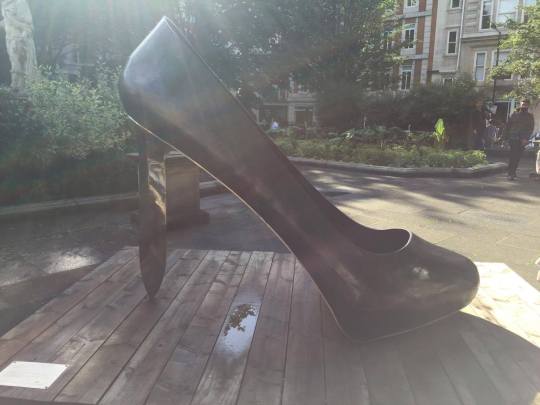
Do you. Do you get it. It’s. It’s a stiletto heel I love visual puns.

Tour guide on the Blake Walk had bright purple, evidently waterproof moccasins.
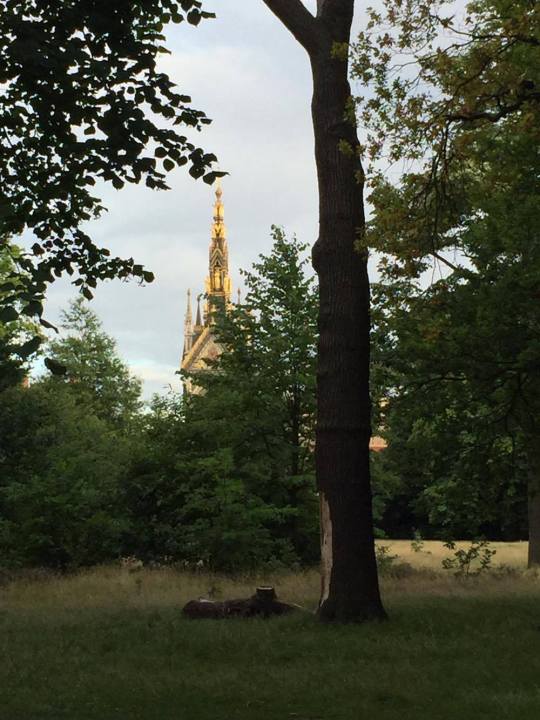
I went on a walk in Hyde Park, and honestly it could have been just like any walk in the Wissahickon, except that occasionally, through the trees, one can catch a glimpse of golden spires, and you can understand why so many authors from England have written stories about mystical castles in forests. Narnia, Hogwarts, Middle Earth, so on and so forth.

I mean, they’re not wrong. It is a round pond. It is a very round pond. It’s got very little other features than being round. And a pond.



Unless any of these are curse words that I really don’t understand, the graffiti on public transit here is very different from the graffiti in the states.
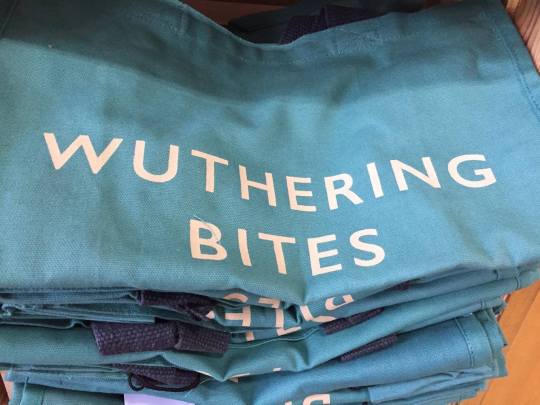

Puns are great.

Same, Lola, same.

We went to see Baby Driver early on in the trip (great movie, by the way, if you like good soundtracks and well-choreographed car chases, which I do), and this is the size of their small popcorn and small slushy. That cup was the size of my hand. The one in the states is the size of my head.
It was perfect, though, really, because it hadn’t melted by the time I finished, it wasn’t enough to make me feel uncomfortably jittery with sugar, it didn’t give me a brain freeze. I support this smaller size. And no, it has nothing to do with it making me look normal sized, which is what some people suggested.
#london#travels#I figure you'd rather here about weird things in London than about me sitting in my room writing a paper#food#if that can be considered food which I have a lot of doubts about#the ginger shot not the popcorn the popcorn was great
0 notes
Text
Tuesday, August 8th 2017
I hadn’t realized, because of that whole you-never-know-you-love-it-until-it’s-gone-and-then-you-still-don’t-know-it-until-it-comes-back-and-you-realize-how-much-you-missed-it thing, how much I genuinely like the murals in Philadelphia.
We play this game, sometimes, driving through center city, called can-you-drive-for-more-than-a-block-without-seeing-a-mural, and we lose almost every time.
That being said, I didn’t even notice how much I was missing the riotous color of my city until we went on a street art tour of Brick Lane.
Interestingly enough, the man leading the tour was the same person who, a year ago, led a street art orientation tour for me and other classmates during my first study abroad trip to London. That one was on the riverside, from the Globe to the National Theatre, which was lovely, but it had nothing on the street art in Brick Lane.
Brick Lane is an area of London that was once settled by Jewish immigrants, and then Bangladeshi immigrants, and is now being slowly but surely taken over by hipsters and sixteen pound cupcake stores and every other classic sign of gentrification. According to a classmate who’d been around here before, the best bagels in the world could be found just up the street from where we were standing to begin the tour. According to our tour guide (and corroborated by my Indian professor), the best samosas in London could be found just up the street in the opposite direction. We were shown a building that had once been a church, and then became a synagogue, and was currently a mosque. If it weren’t for the utterly demoralizing number of cafes called things like Naughty Avocado, it would be the most interesting place I’d been to in London.

(Just in case you thought I was kidding about that.)
The street art (not graffiti, our guide was quick to say, they are apparently entirely different things) had not yet been entirely stamped out by the gentrifiers (who you’d think would like some good old-fashioned street art, but apparently street art doesn’t sell), and was lovely.
Highlights:

Space invader, missing some tiles but still side eyeing the building next-door (a new-fashioned bar called The Old Bar).

Some super close to home art that is, nonetheless, stunning.

Usually I don’t like other people making fun of my country, because you don’t have to live there, thanks, but in this case I’m making an exception because same, anonymous person, same.

This is my favorite. In case you were wondering how large it is, those tiny heads in the bottom corners are adult, standing human beings.
After the tour, I was supposed to go back to the center to have a meeting with the professor who runs the independent study, but as he was also on the tour, so instead of going all the way back, we bought some samosas (delicious, by the way), found a cafe with wifi, and had our meeting there. Mostly, we discussed the book that I read the day before, which I entirely forgot about needing to read until about 11:30 that night. Fortunately, I’m a fast reader, and we’d finally reached the modern children’s lit, which is my reading speciality. The Apothecary, by the way, is an excellent book, and my greatest regret is that I finished at 1:30ish in the morning, and had class early the next day, which meant that I couldn’t read the following sequels.
We finished the meeting, and there ended the interesting parts of my day.
#london#travels#museum review#book review#sorta kinda I mean I talked about a book and art that counts as a museum right#the samosas make it 100% more interesting than any museum I've ever gone to really#we couldn't decide whether that was a possum or a porcupine by the way so place your bets#also the difference between graffiti and street art#is the tagging under the possum and the possum#apparently#I would argue that some graffiti is street art but that's neither here nor there#food
4 notes
·
View notes
Text
Monday, August 7th 2017
I woke up and decided to write my final paper on In The Mood For Love’s costuming. Intelligent, because I know nothing about fashion, or movie sets, or literally anything to do with Chinese history.
Here’s what you need to know about In The Mood For Love: It is a “visually appealing” film, according to a film major in our program, that has exactly no plot, which is why he’s had to watch it in every film class he’s ever taken.
The plot, if you can call it that, is that two neighbors (Mrs. Chan and Mr. Chow) meet, and figure out that their significant others are having an affair together. They proceed to eat and drink tea in various locations, vaguely discuss the rudeness of their respective spouses, and do nothing about it. They never confront them, they never have an affair themselves, and then Mr. Chow moves away and Mrs. Chan goes on with her life.
A supremely uninteresting movie.
So, naturally, I picked that to write on.
My theory, based on what I vaguely remembered of the bits of the movie I stayed awake for when we watched it the week before which, given that I was sick and also bored out of my mind, were not many, was that the way Mrs. Chan’s beautiful clothing reflected, matched, or utterly clashed with the background was indicative of her mental state during each scene. That was formed primarily because by far the most long-lasting impression of the movie was that Mrs. Chan wore stunningly beautiful clothing.
After quite a bit of research, and also spending several hours watching through the movie and screenshotting literally every scene in which Mrs. Chan appears in order to compare her clothing and the background, I discovered that not only did my mildly crazy theory have merit, but it went far deeper than that. The costumers of Mrs. Chang, you see, were designed by a man named William Chang Suk-ing, who was also the main artistic director. He’s apparently a genius in the film industry, and made 46 pieces for Mrs. Chan to wear, all in a very distinct style.
They’re called cheongsam, which I initially tried to look up in the Oxford English Dictionary. Of course, it being the Oxford English Dictionary, I did not get far. This is what happens when English majors try to do research on foreign language films. It does not go well.
Cheongsam were originally invented in the Qing dynasty, centuries ago, but were redefined in the 1920s to be more form fitting and restrictive. They’re fascinating, because, they represent directly a period of turmoil in Chinese history, when the last heir of the Qing dynasty abdicated, and various military leaders competed to rule China. That style of dress had gone out of style by the 1960s, when the movie was set, so the decision to dress Mrs. Chan exclusively in these outfits was a clear callback to the strife of the earlier time. Or, at least, that’s what I put in my paper.
Her clothing also really did match up with the background when she was happy, and distinctly didn’t when she was miserable. So I could use that too.
My favorite thing about English classes is that basically writing papers on symbolism means coming up with crazy conspiracy theories, and if you can come up with enough proof, they can absolutely be true. Everything is symbolic! Death of the author! Everything is possible!
After coming up with 26 pages of screenshots and theories, I quit working to attend the screening of Brick Lane at the center.
Brick Lane, about the experience of a Bangladeshi immigrant woman in London. It was actually one of the best films we watched all term, even if it did involve an affair, which I’ve just come to expect at this point. It ended happily, though. I’d cautiously recommend watching it, which I would not do for any of the other films.
After the screening I had a short meeting with my professor about the ridiculous topic I was considering for my paper, and she gave me her blessing, so there.
I don’t know what point I’m proving, and to what person, but I proved it.
#london#travels#movie review#the trouble with my tunnel vision on this particular topic#wasn't really that I didn't know anything about the topic#because last semester I had tunnel vision on a paper about Julius Caesar's epistolary propaganda in the civil war of the first century BCE#and I didn't know anything about that either#but I knew how to find the information#I didn't have the slightest clue where to start looking for stuff about filmography and Chinese fashion#hence the misguided attempt with the OED#it took me more than half of my time spent working just looking for the proper search engines and the right sources#I miss my classics courses
1 note
·
View note
Text
Sunday, August 6th 2017
In my notes for this day, and I do take notes, thanks, because I am absolutely that much of a nerd, I have ?????
I don't know what that means, and I have very little memory of this day at all. I was recovering from illness and trying to plan out my two final papers (one of which was due on Thursday, the other which I had to come up with an outline for by Friday, neither of which I had the slightest clue what I was going to write about), and I believe I ended up spending the day staring at all of the work I had to do, and then doing nothing at all.
I believe I watched the entirety of Dirk Gently's Holistic Detective Agency for the third time in possibly as many days. It's an excellent show.
It’s based on a book by Douglas Adams, which I have never read but will at some point track down.
Dirk Gently is British and only wears primary color leather jackets and is a holistic detective which apparently means he follows the 'connections of the universe' and doesn't believe in 'clues’.
Todd is Elijah Wood and Does Not Want to be the Watson to Dirk's mildly insane Holmes, but Dirk is Very Convinced that the universe is telling him that they Belong Together in an unspecified way.
There is also a Holistic Assassin, who kills people based on the connections of the universe, which may, to others, look mildly like a psychic serial murder spree.
It’s a great show that has very strong, very distinct characters, excellent, excellent writing, and a genuinely interesting mystery with some twists that I promise you won’t see coming.
It’s fairly short, just eight episodes of about 40 minutes each, but it’s also only season 1, and there is a confirmed season 2 happening at some point in this calendar year, so.
So.
Yeah. Go watch that.
I also realized that I never told you one of the more amusing stories of weird things that have happened, if not to me, then at least in my general vicinity, in London, and as I don’t have anything else to talk about at the moment, I figured that I could tell you about it.
So we were walking in Hyde Park, pretty early on in our time in London. (My notes from this are from July 8th.) It was evening, the sun had just set, so we were heading back to the house, when we saw an odd gathering of people around the Queen Victoria Memorial Fountain. Naturally, we went to investigate.
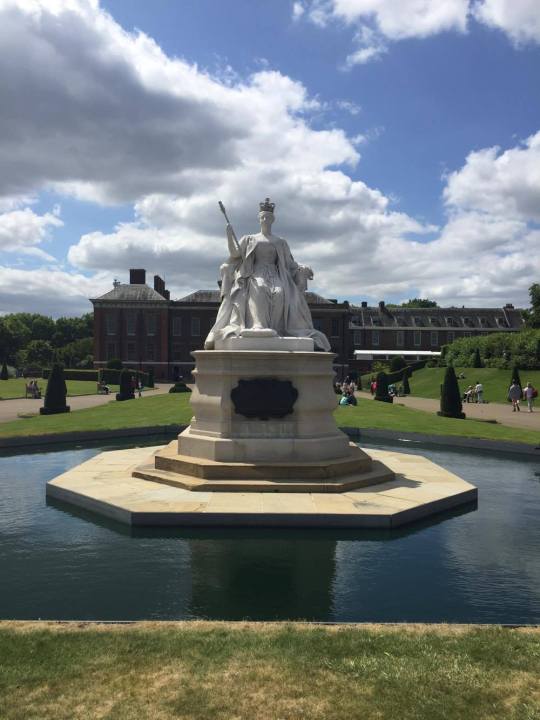
There were a group of cops nearest to the fountain, all giving completely opposing instructions to a guy lying on the ground with half of his arm stuck in the pond, clearly trying to reach something.
Eventually, the guy got up, empty handed, and conferred with his colleagues for a few minutes.
Now, just so that you can picture this clearly, there were like seven or eight cops there. Most of them were in the florescent yellow vests that police wear around here, but the guy who’d had his arm in the fountain was in what looked more like a tactical vest, you know, the navy ones that cops in the states wear, and there was also a guy in a suit with them.
For some reason, after the guy in the vest got his arm out of the fountain, the guy in the suit took off his jacket and rolled up his pants and got into the fountain.
At this point, one of my friends went over and asked one of the less involved police officers what was going on.
It turns out that they were searching the pond because one of the officers had lost his gun. In the pond.
The guy in the suit was going in, rather than any of the ones, you know, not in a suit, because he lost a coin flip.
It was all a little ridiculous, honestly. Very funny, though.
They did eventually recover the gun, to much applause from the gathered crowd, and then shooed us all out of the park, as it was by then quite dark. A truly entertaining end to a quiet after dinner walk, I have to say.
#london#travels#show review#sure let's make that a tag#I suppose the slang for police isn't actually cops here is it#ah well I don't feel like rewriting everything so cops it is
1 note
·
View note
Text
Saturday, August 5th 2017
I realize that I may have given you the impression that my life had picked up some since I had a week off and didn’t talk about all of the boring bits, but that was rather misleading, I’m afraid.
Post-lake district trip I was still rather ill, though getting better all the time, really. I spent the day writing a paper about the emergence of the genre of fantasy in children’s literature.
It was around the beginning of the twentieth century, by the way. Also, my textbook, quite amusingly, ended in 1992. I very much want to see a continuation of the history of children’s literature through to the current day, if only because Harry Potter was published in 1997 and, in my humble opinion, revolutionized the world of children’s literature as we know it.
If I ever do a PhD… Anyway, that’s the most I got up to, because it was due at eight that evening, and between the lake district and being sick, I had written almost nothing.
I did actually ask my professor for an extension, just to midnight that night, but ended up sending it at seven anyway, because that’s just how I roll. Meaning, with very little preparation and a great deal of stress.
I thought I could use this time to update you on the happenings in the missing I-was-sick-and-didn’t-write-anything week. I figure this way I can focus on the interesting things, and leave out anything boring.
Interesting thing one: at midnight during the weekend I picked up American Gods by Neil Gaimon and then four hours later it was four in the morning and I was four or five hundred pages in and desperately curious about what was going to happen next, because it is an incredible read, 10/10 would recommend, but also it was four in the morning. So.
Interesting thing two: Read Peter Pan in Kensington Gardens and Mary Poppins for class, and was surprised by both of them. I’ve never read them, but I’ve seen the respective Disney movies approximately a hundred times, and I figured I had a handle on the stories. Decidedly not, as it turned out, particularly in the case of Peter Pan. The original, you see, involves a days-old baby flying out of his window (babies were once birds, you know) and landing on an island in the middle of Kensington Gardens’ pond, to talk with the fairies, but discovered, when he wanted to go home, that he’d doubted, for a single moment, that he could fly, and then, of course, he couldn’t.
Mary Poppins, on the other hand, is much the same, but without the singing, and without Julie Andrews, so not the same at all, really.
Interesting thing three: I went for a walk around Hyde Park in the rain. The swans were in rare form.
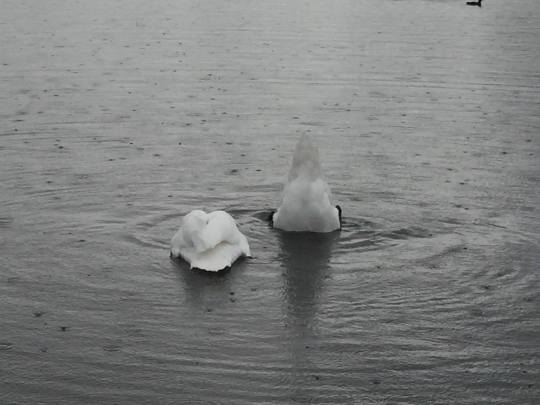
Interesting thing four: We went on a William Blake walking tour, and while I don’t remember much (this was the day before I slept through the alarms, I suspect I was rather ill at the time), I do remember that a woman came up to me and a classmate and gave us each a rose, and then walked away.

Interesting thing five: I don’t know what it is about the phrase “this is a defective train and will not be stopping” makes people flock to the train, just in case it might by some miracle stop and let them on. It’s incredibly puzzling.
Interesting thing six: My mother and her new husband arrived, and I took them to the pancake place. The pancakes were delicious, even if they both were probably too jet lagged to taste anything properly. Pancakes transcend mere physical exhaustion.
#london#travels#after the summer ends I think I shall begin doing a weekly recap of interesting things#rather than full posts#just because being fully back in school#even fully back in school /in Rome/#means that I won't have very many interesting things happening on the daily#or time to write extensively about it#but a week should be more than enough time to gather enough interesting things#book review
1 note
·
View note